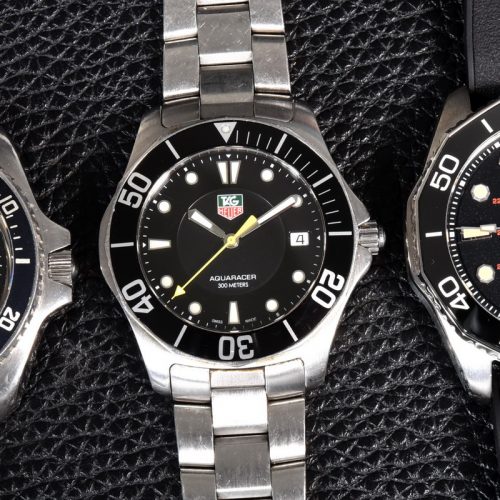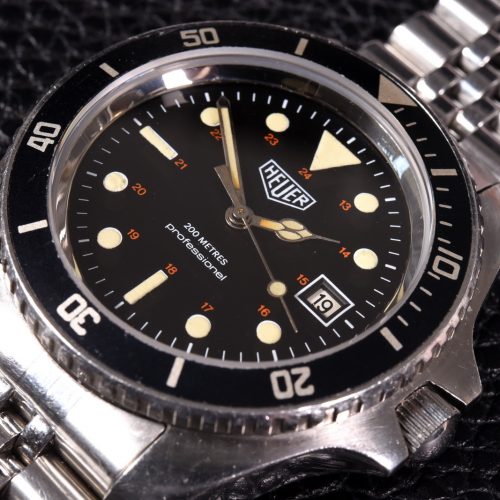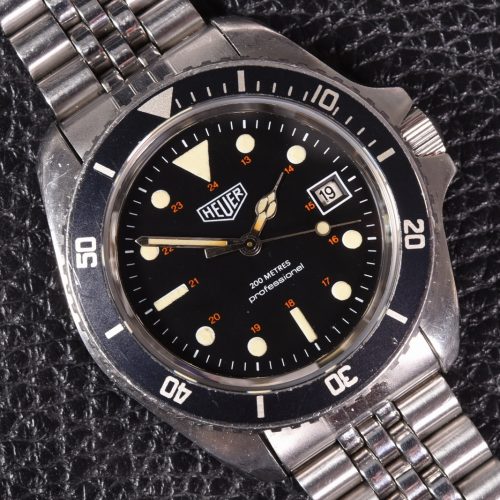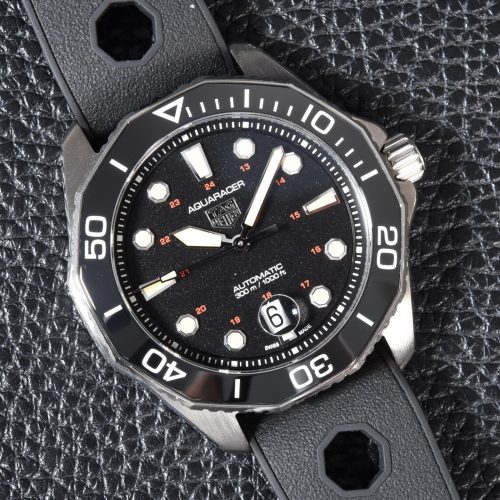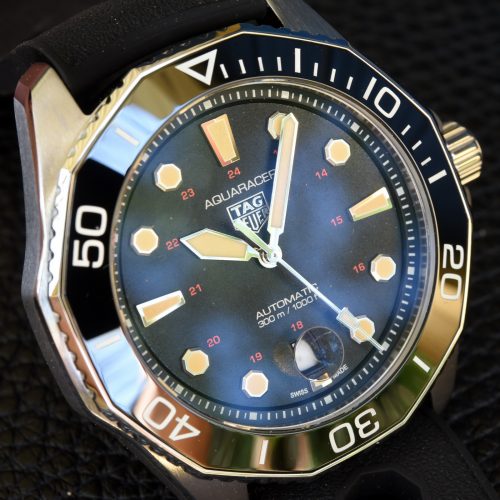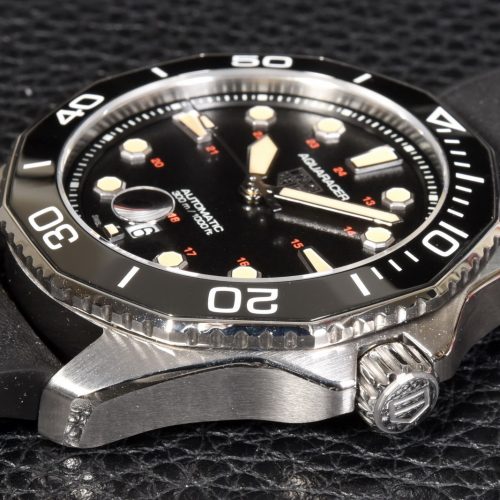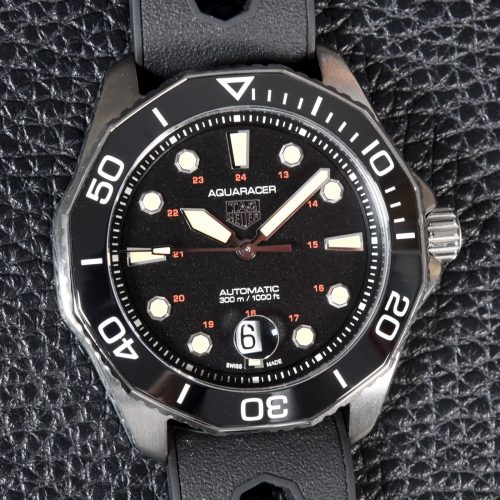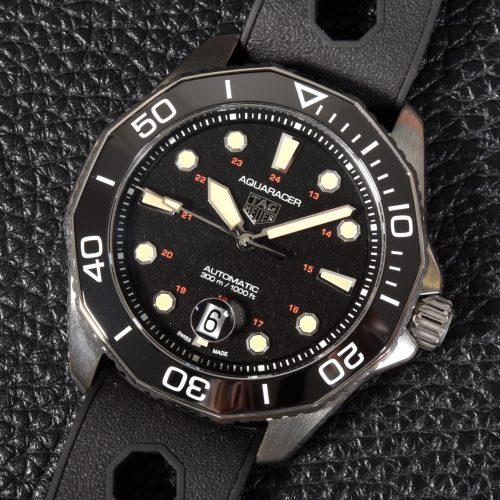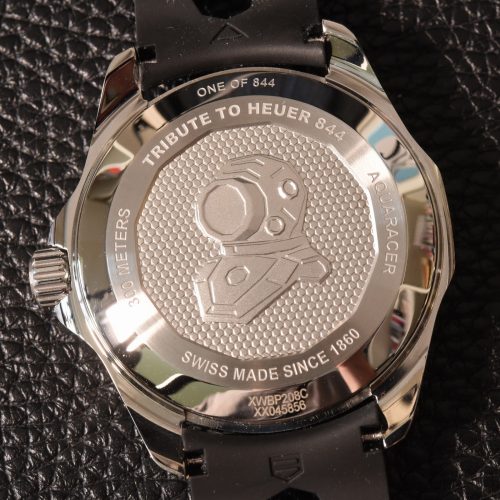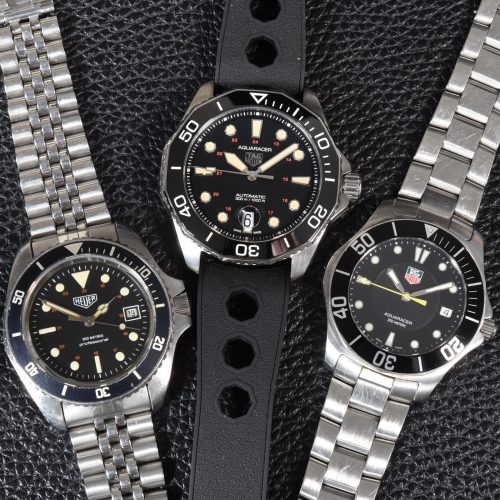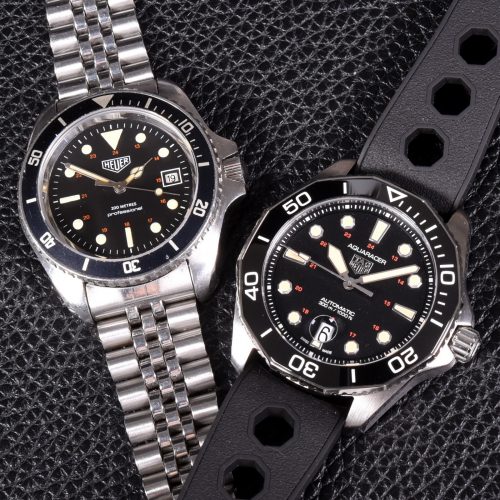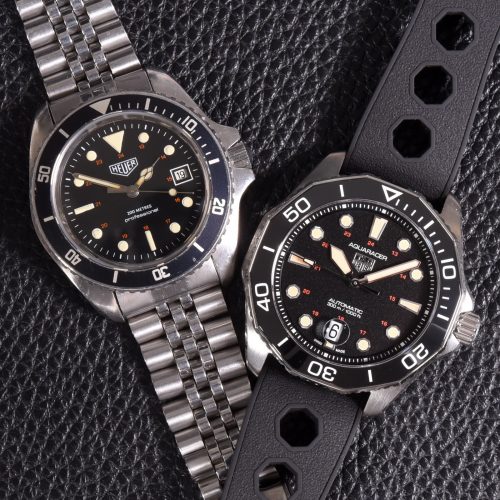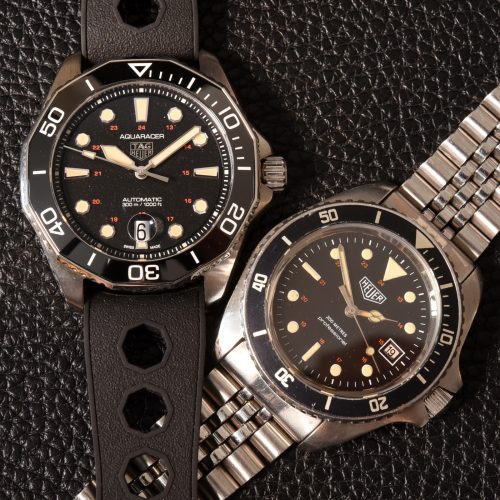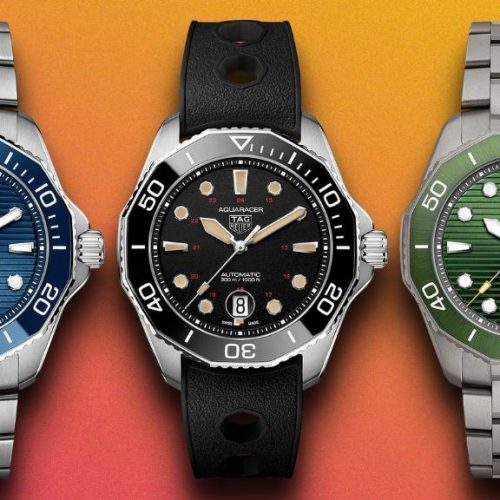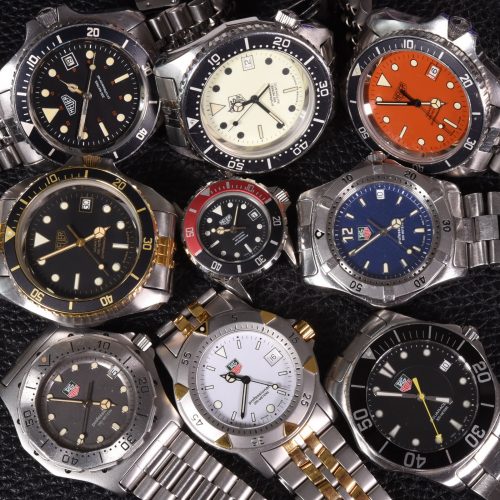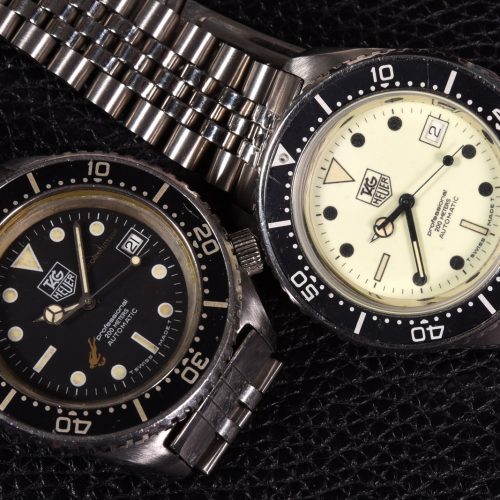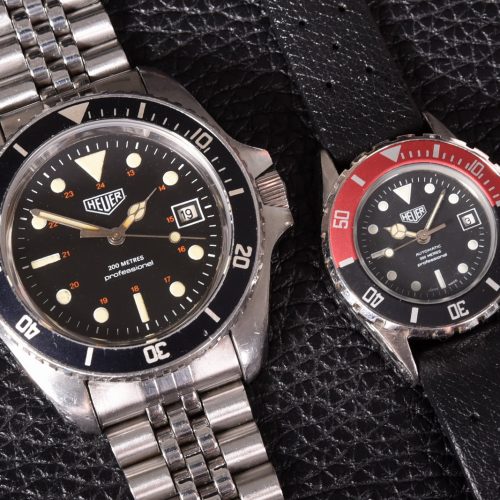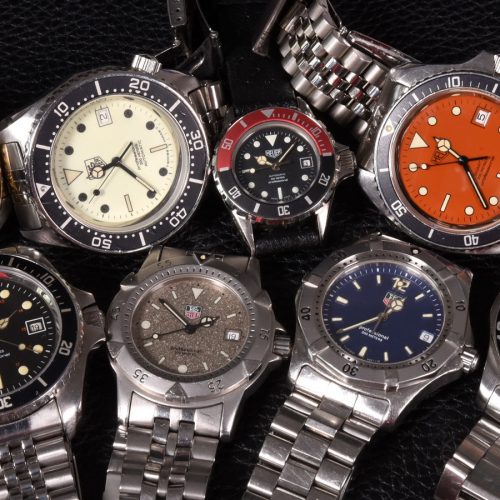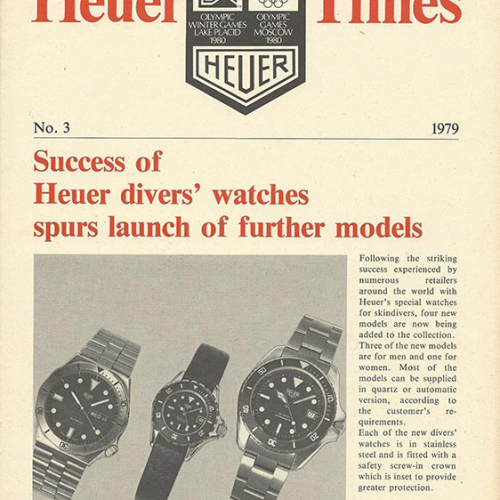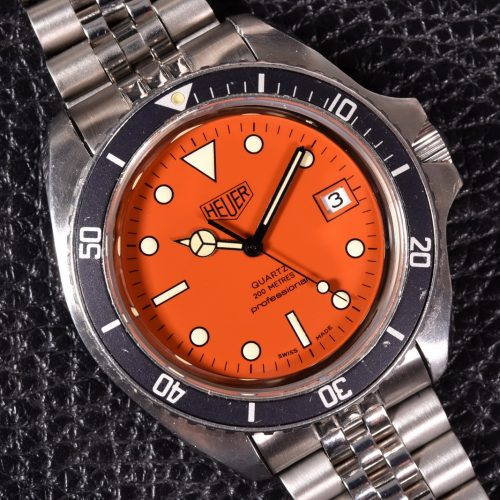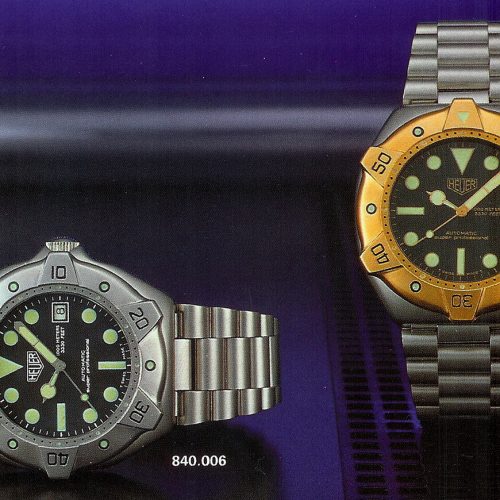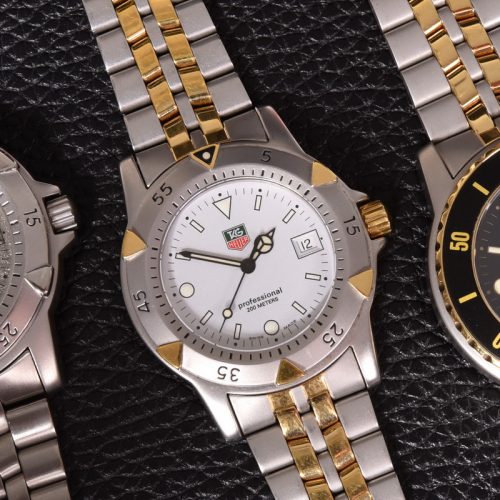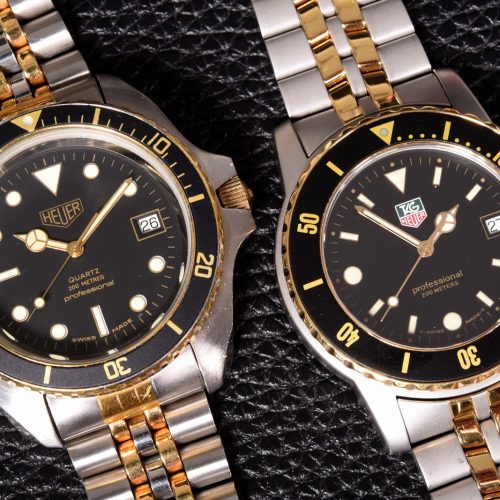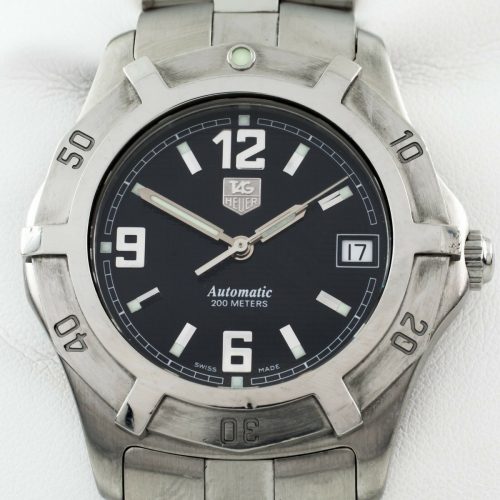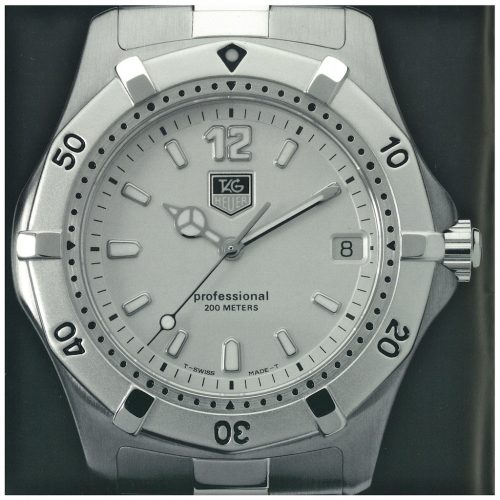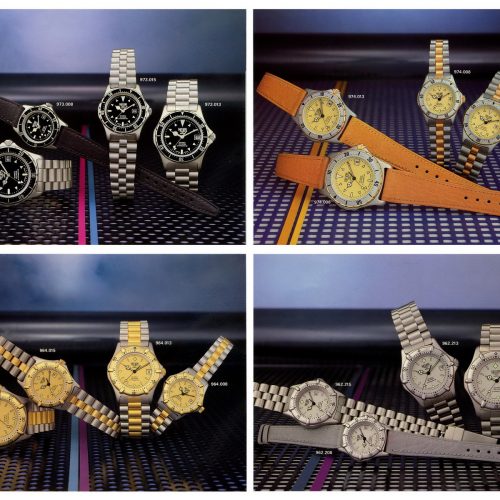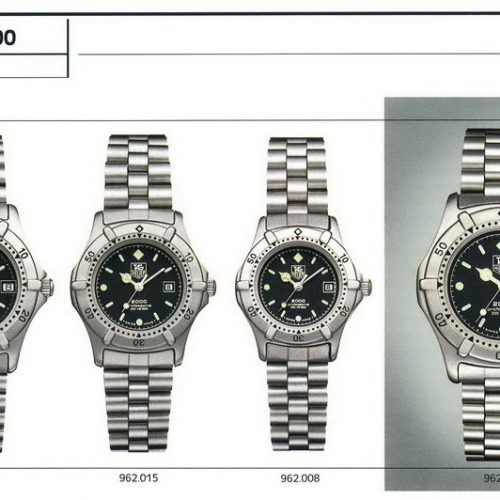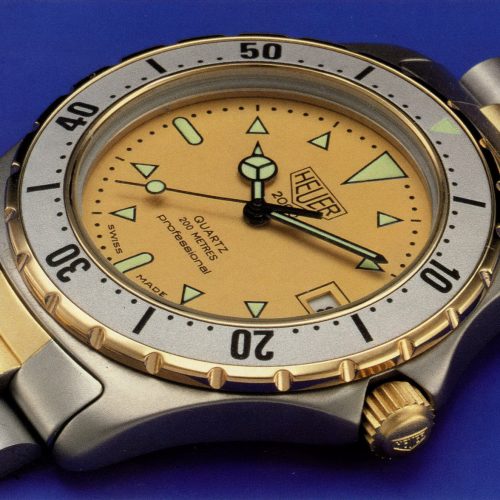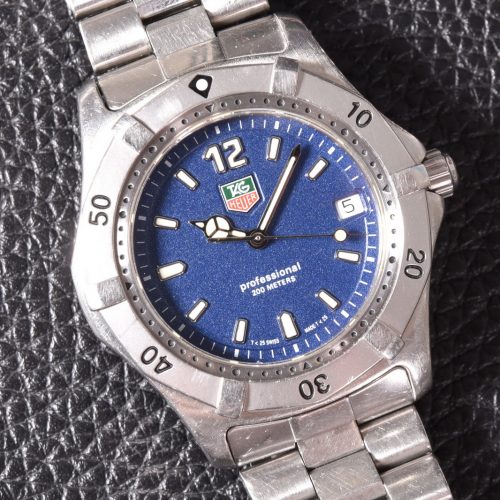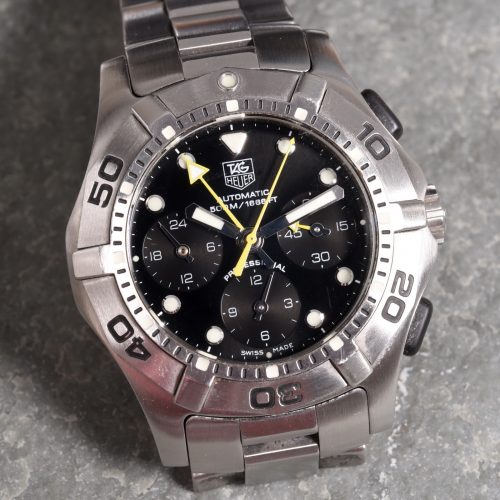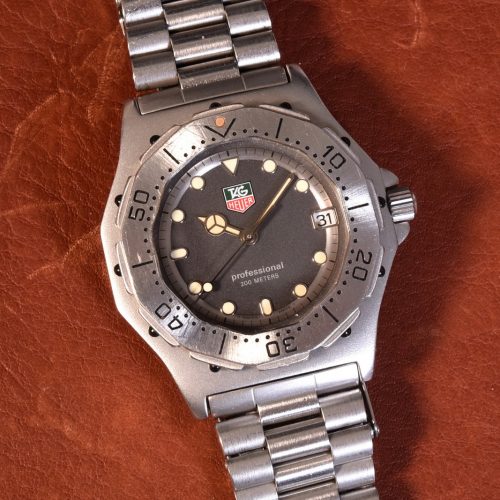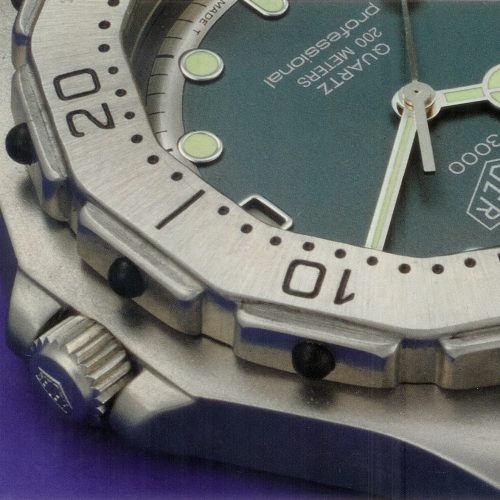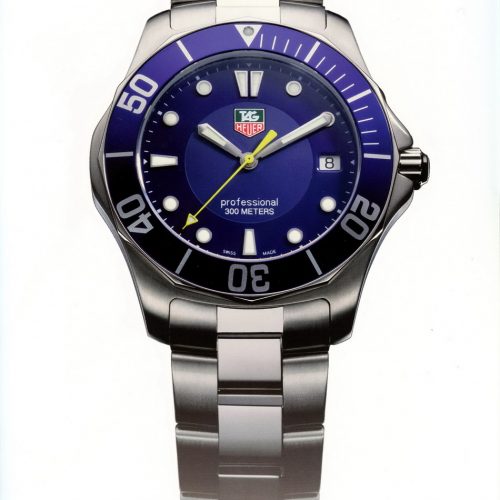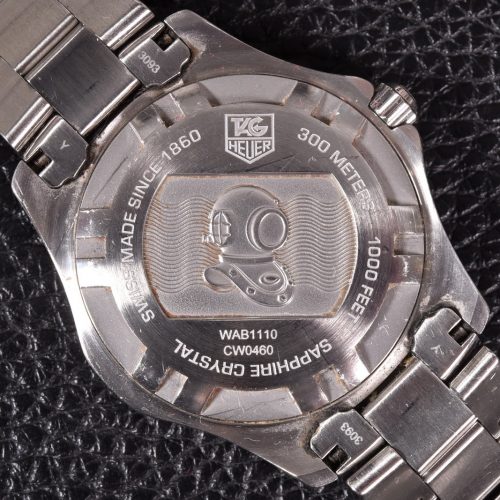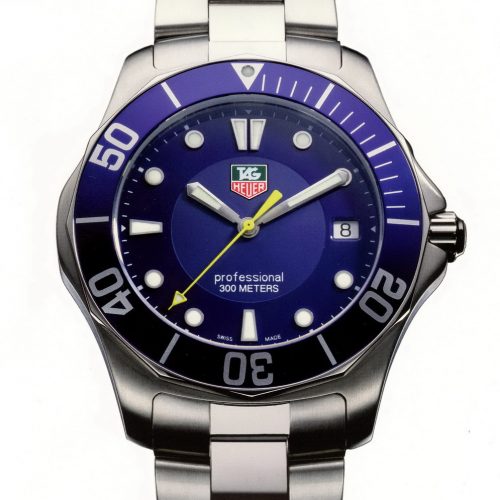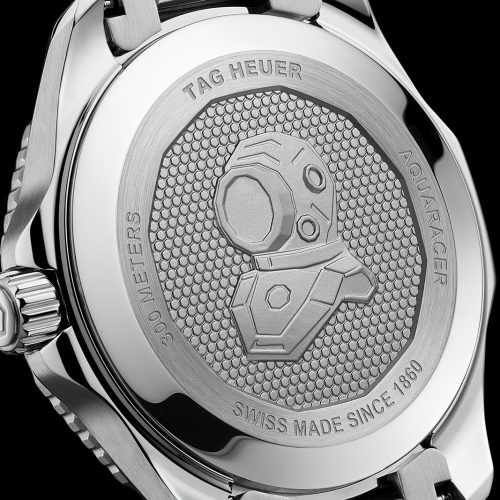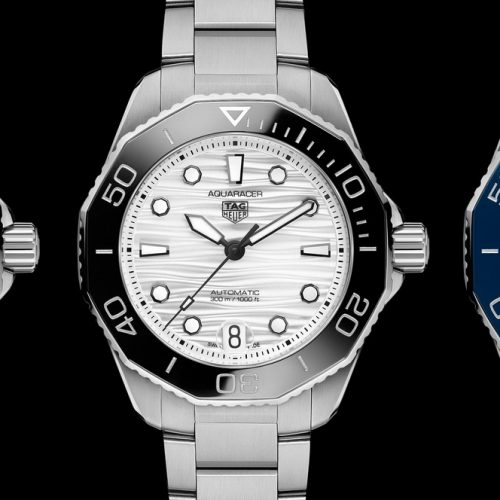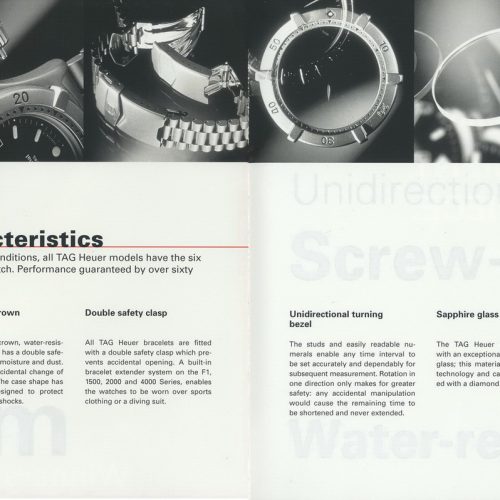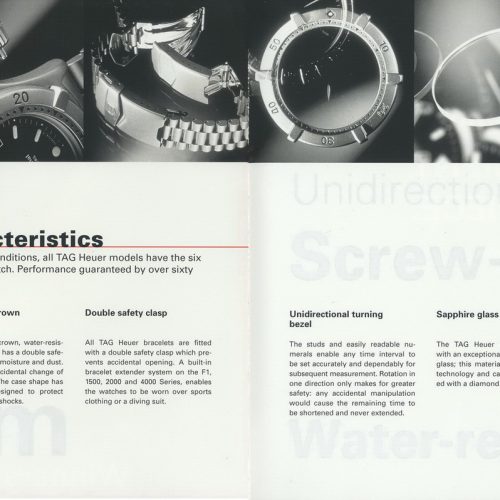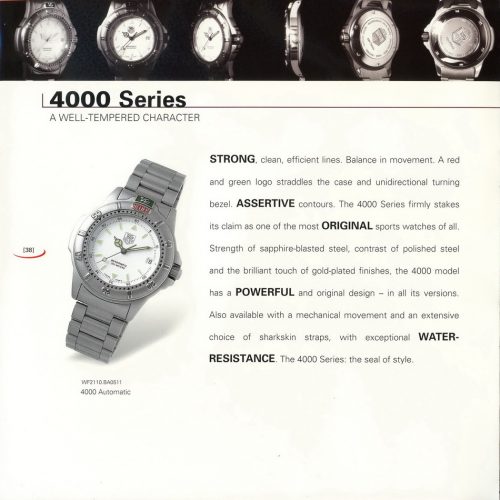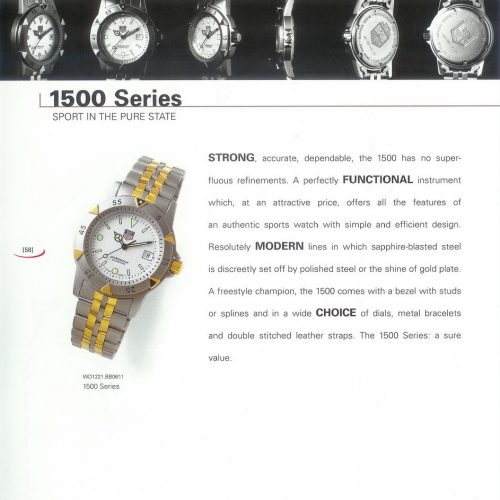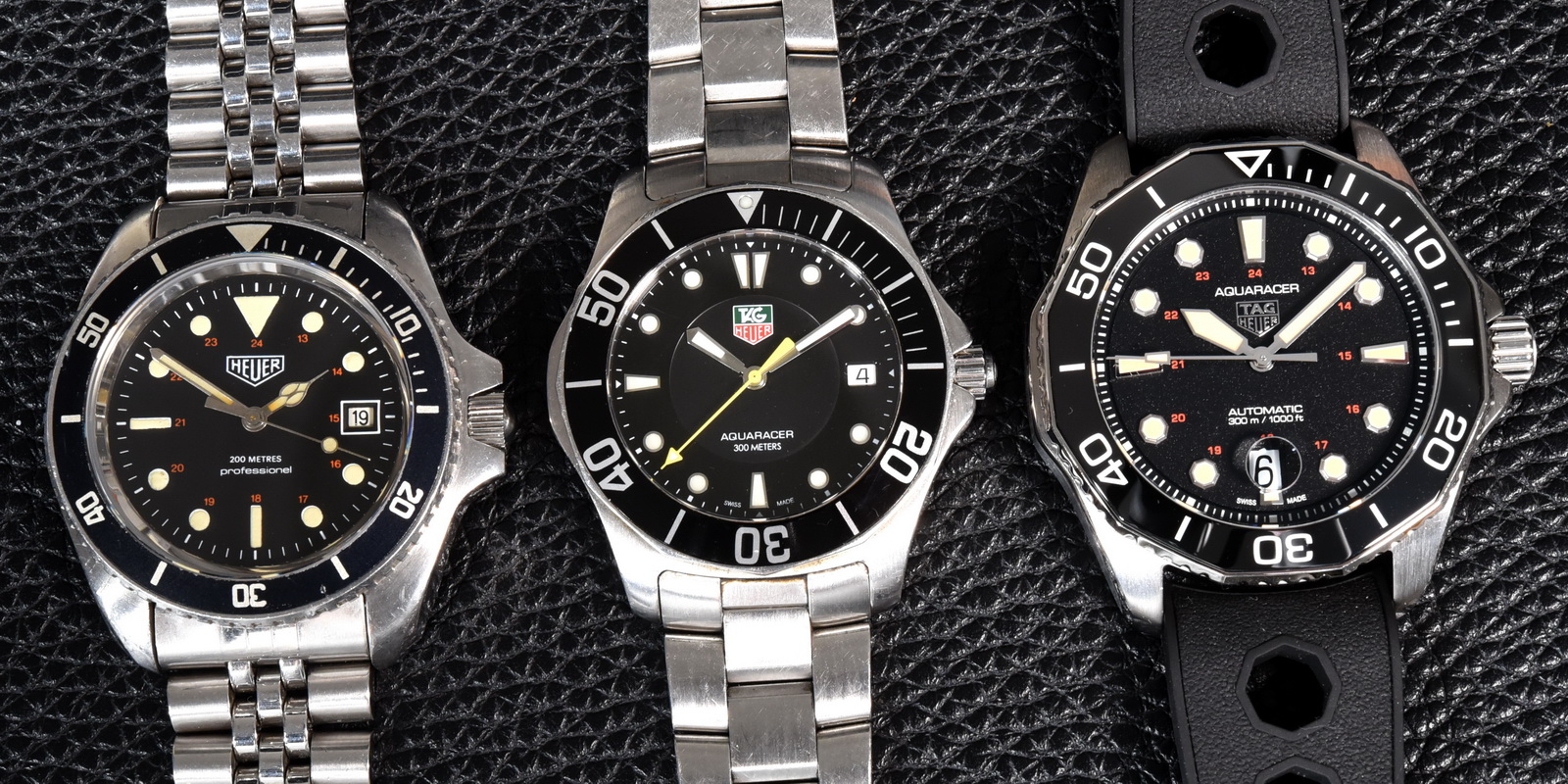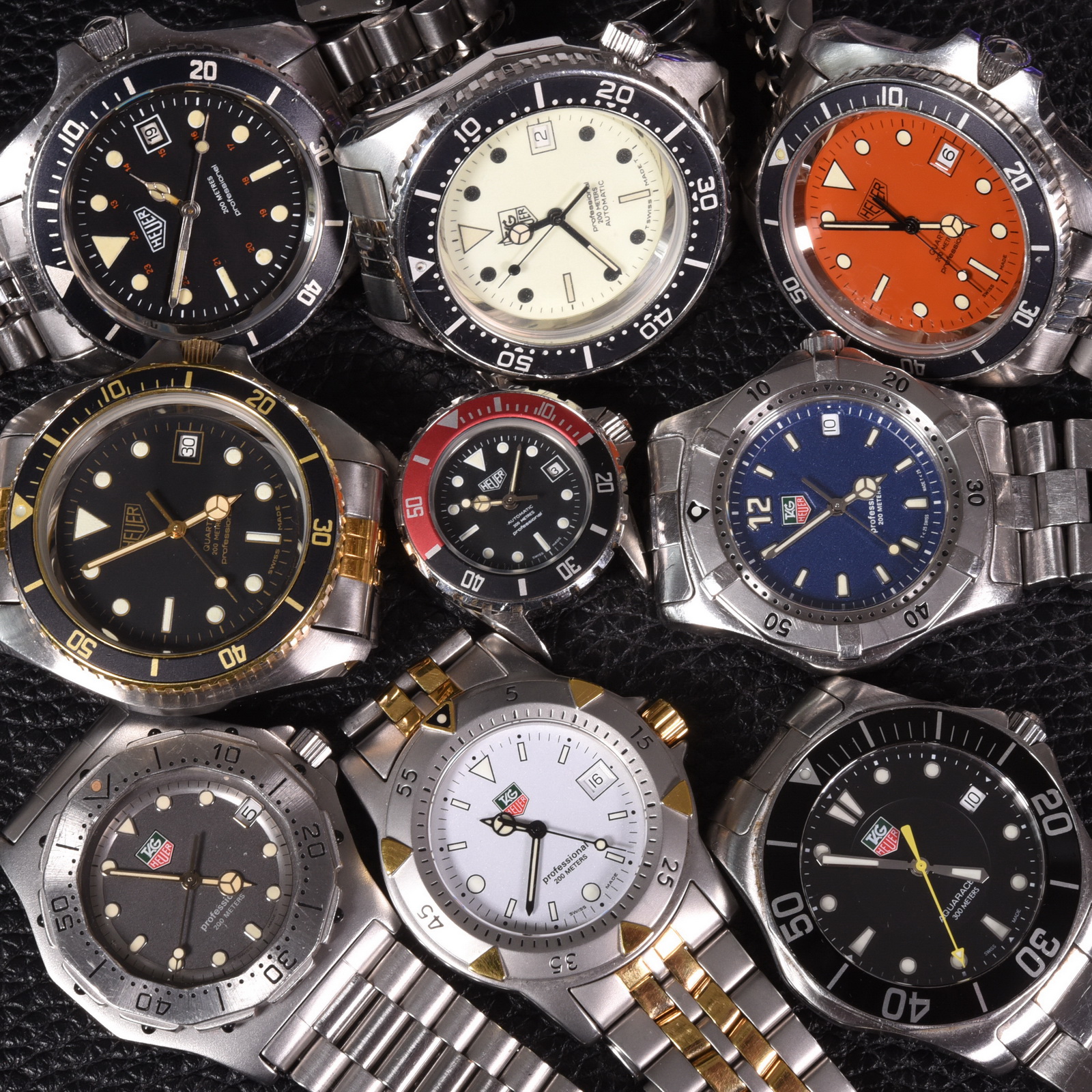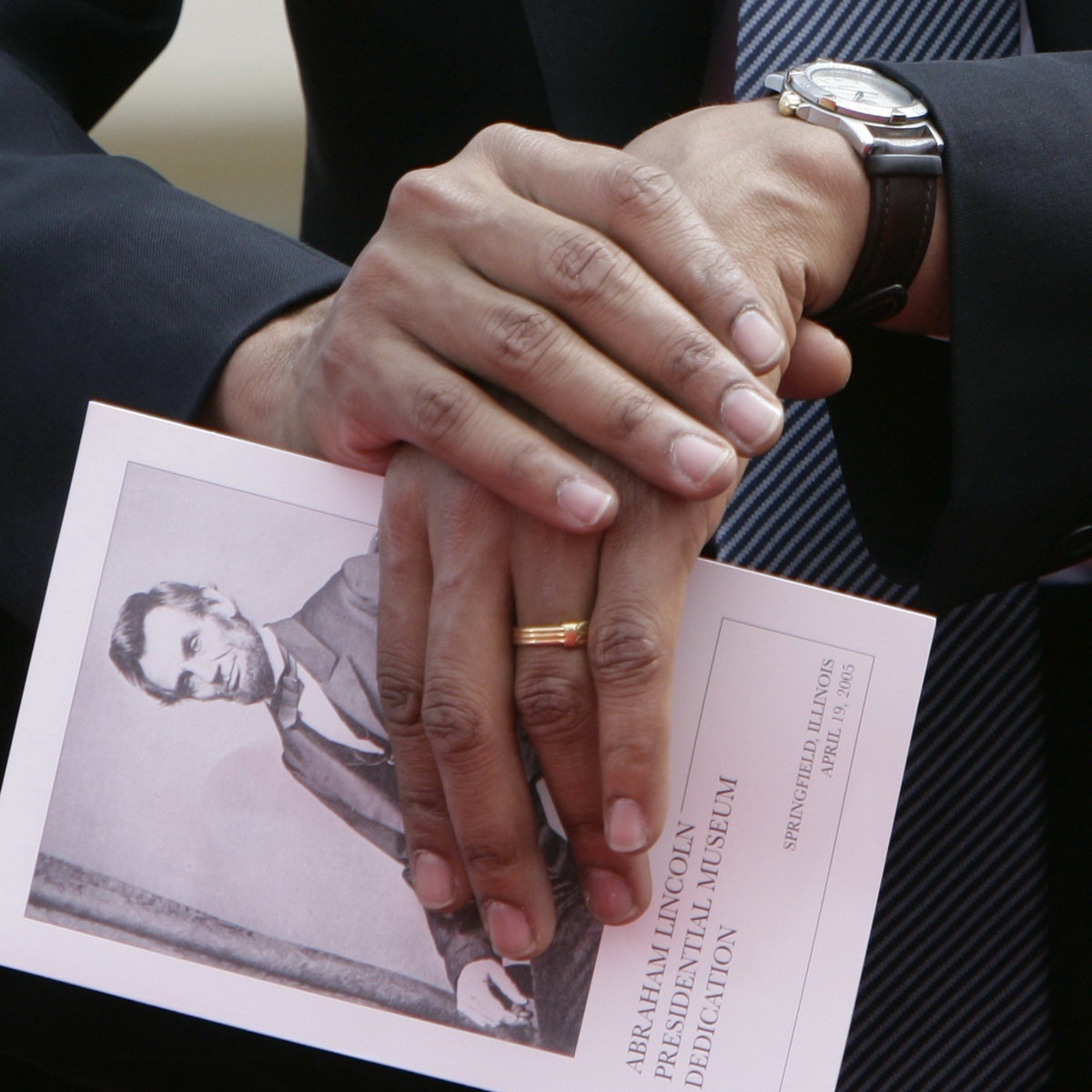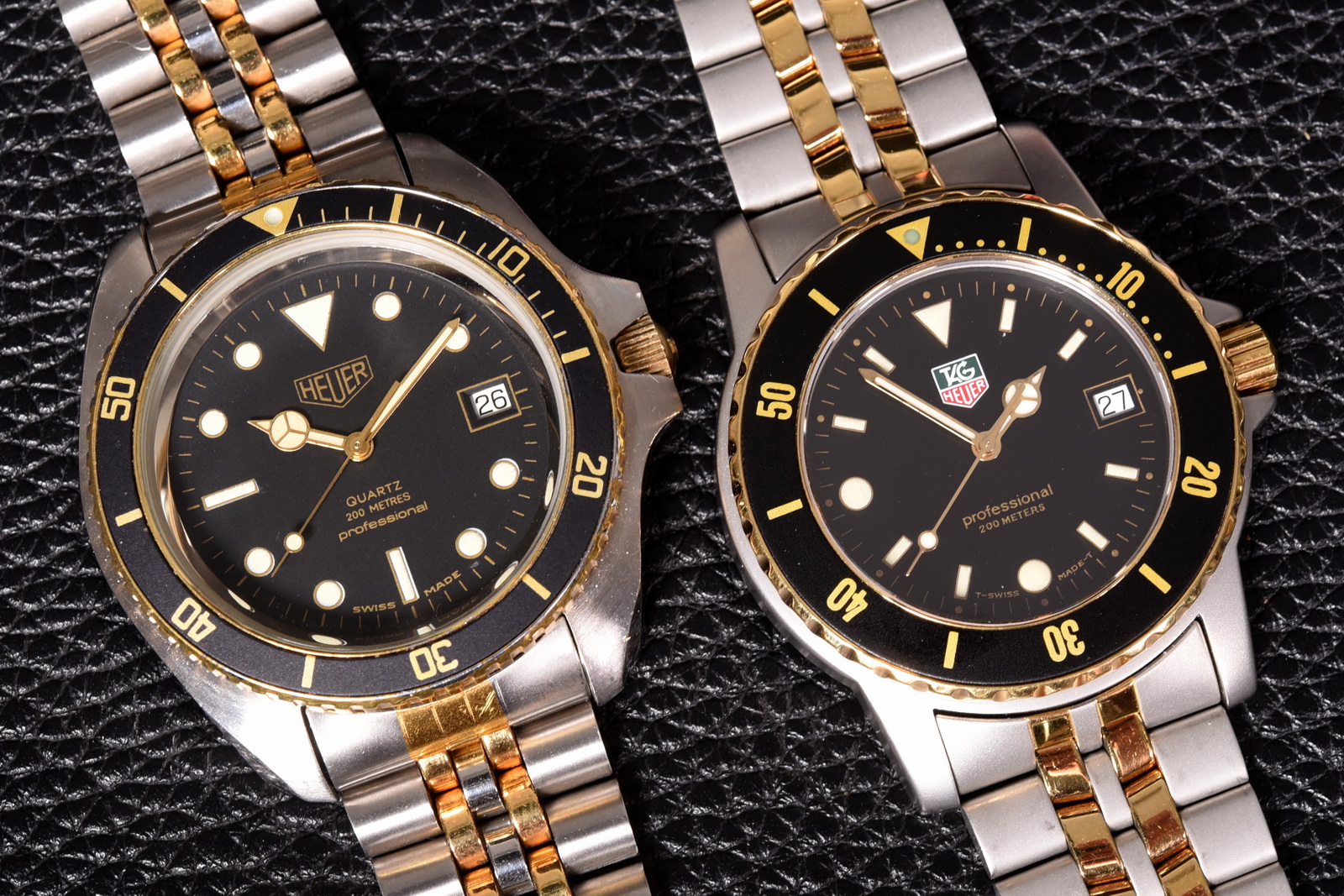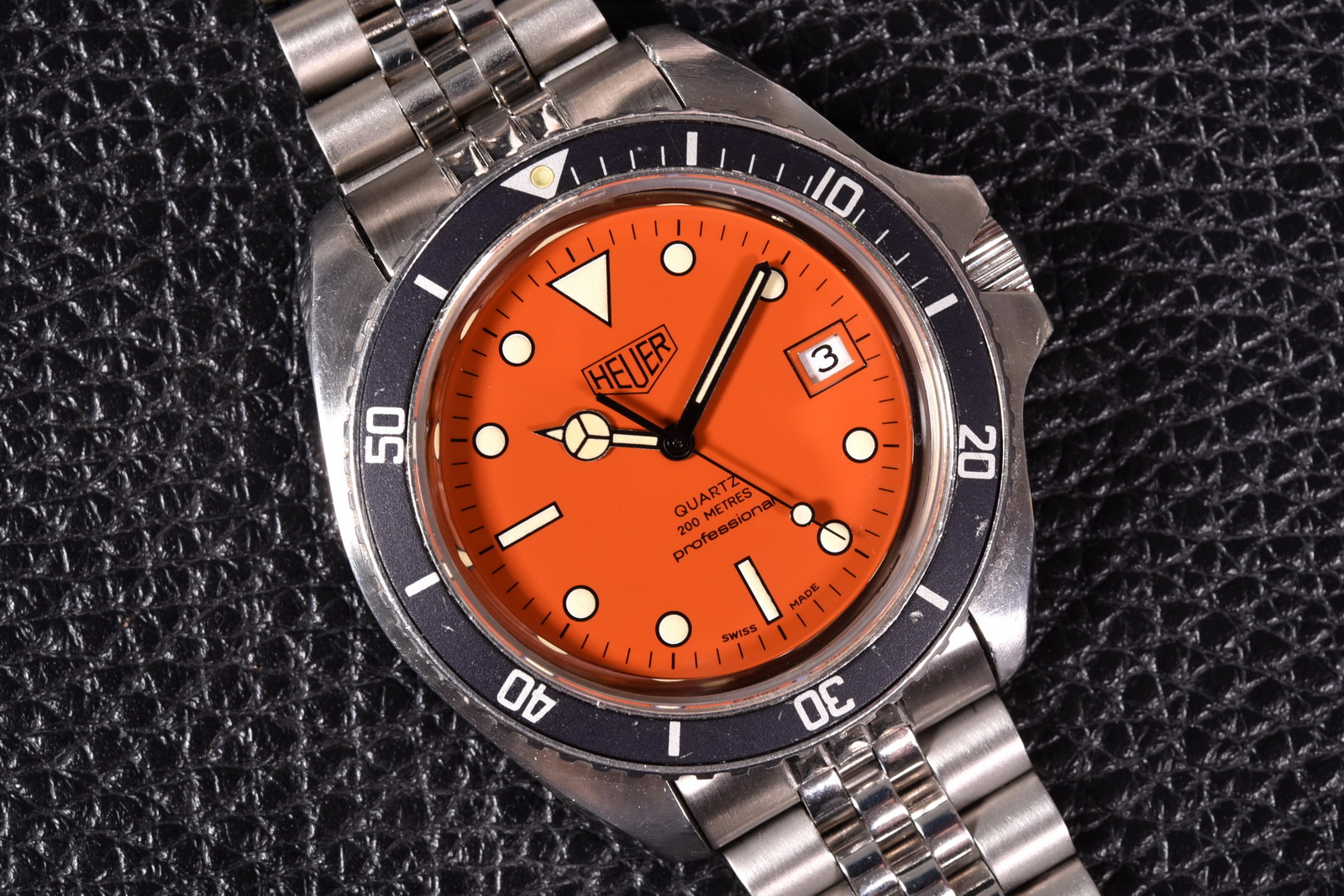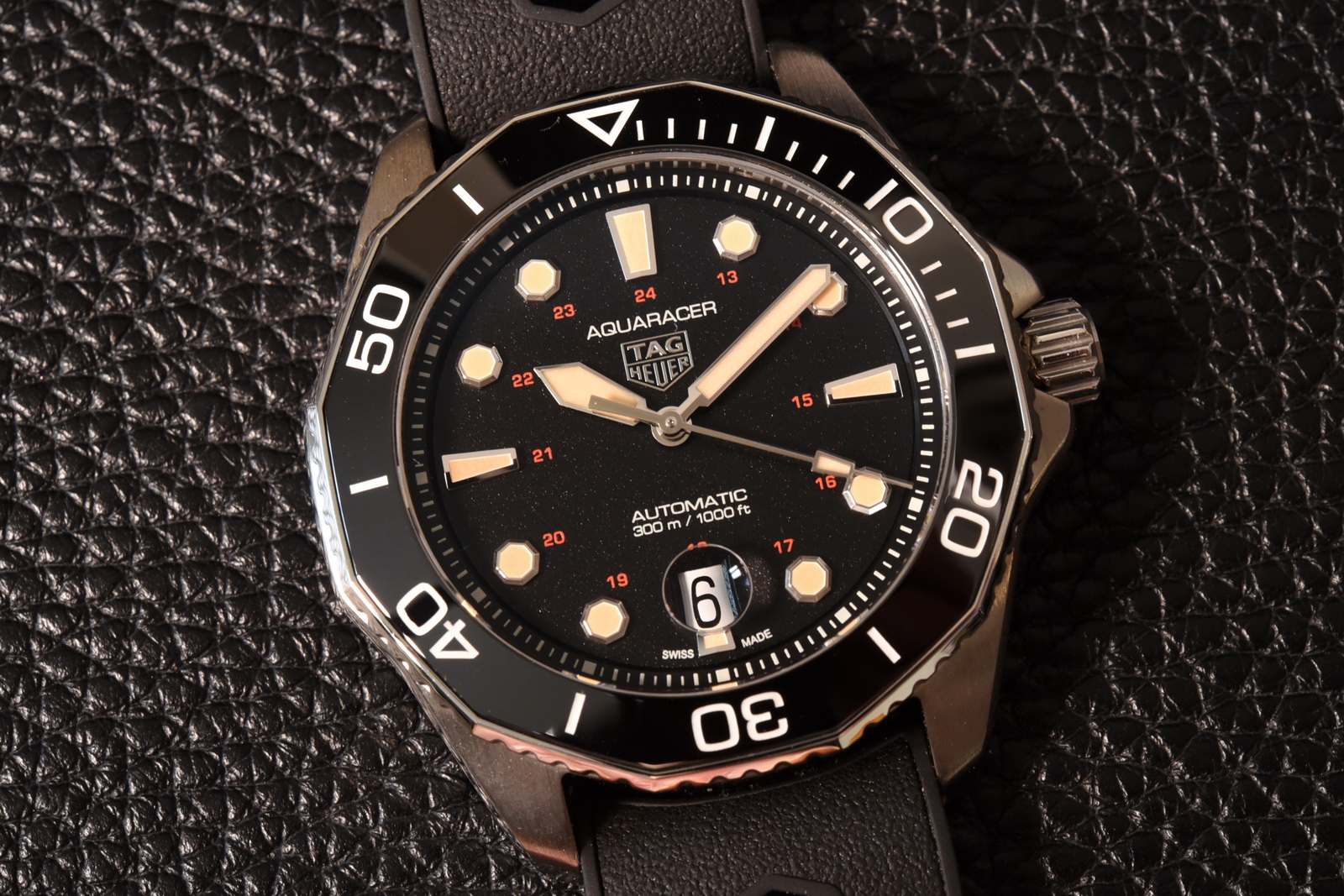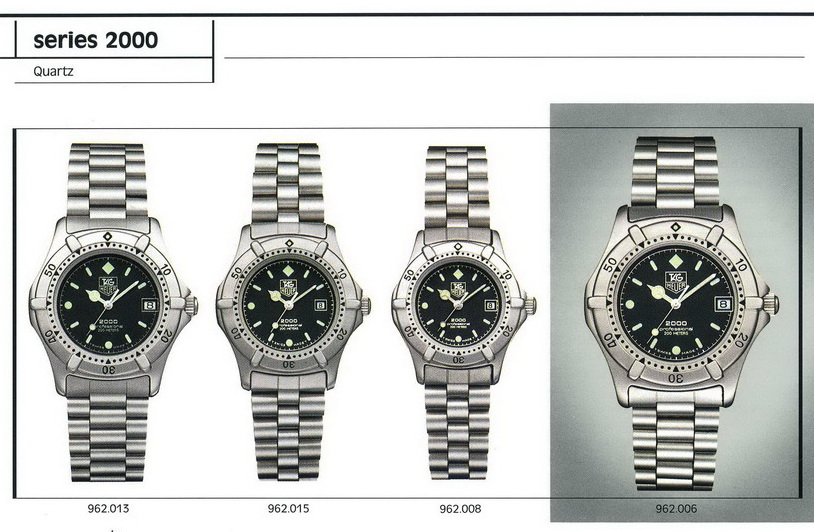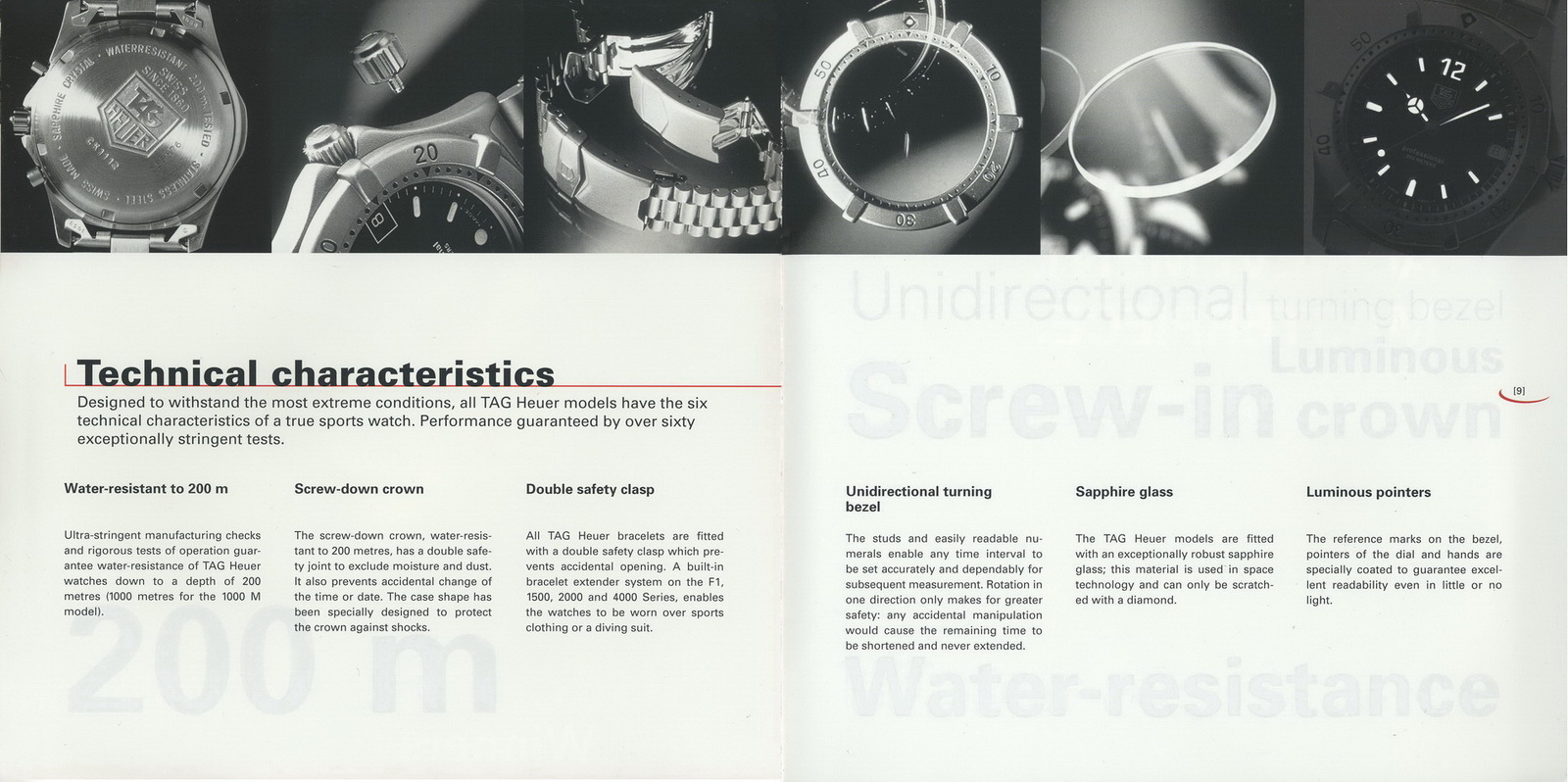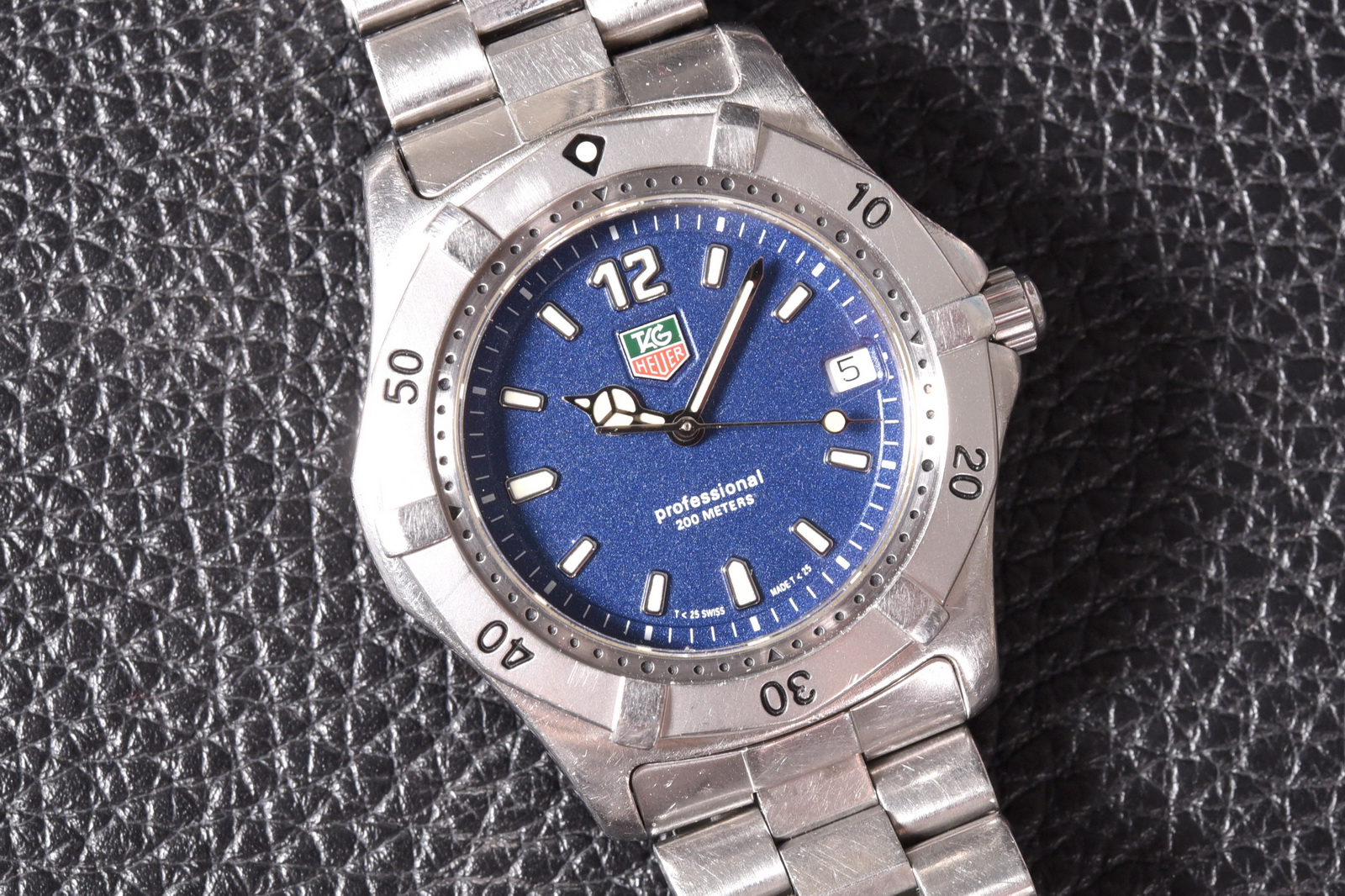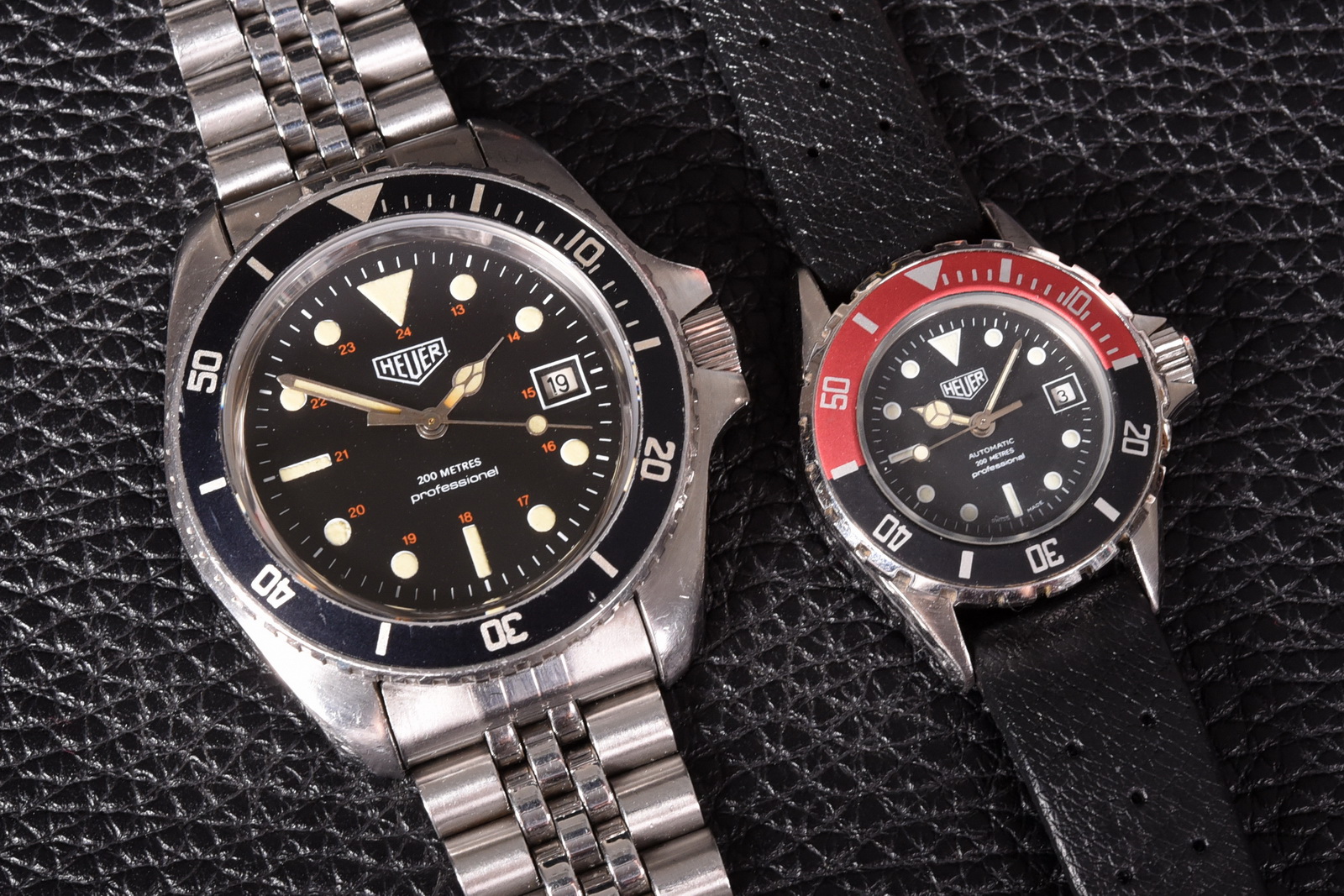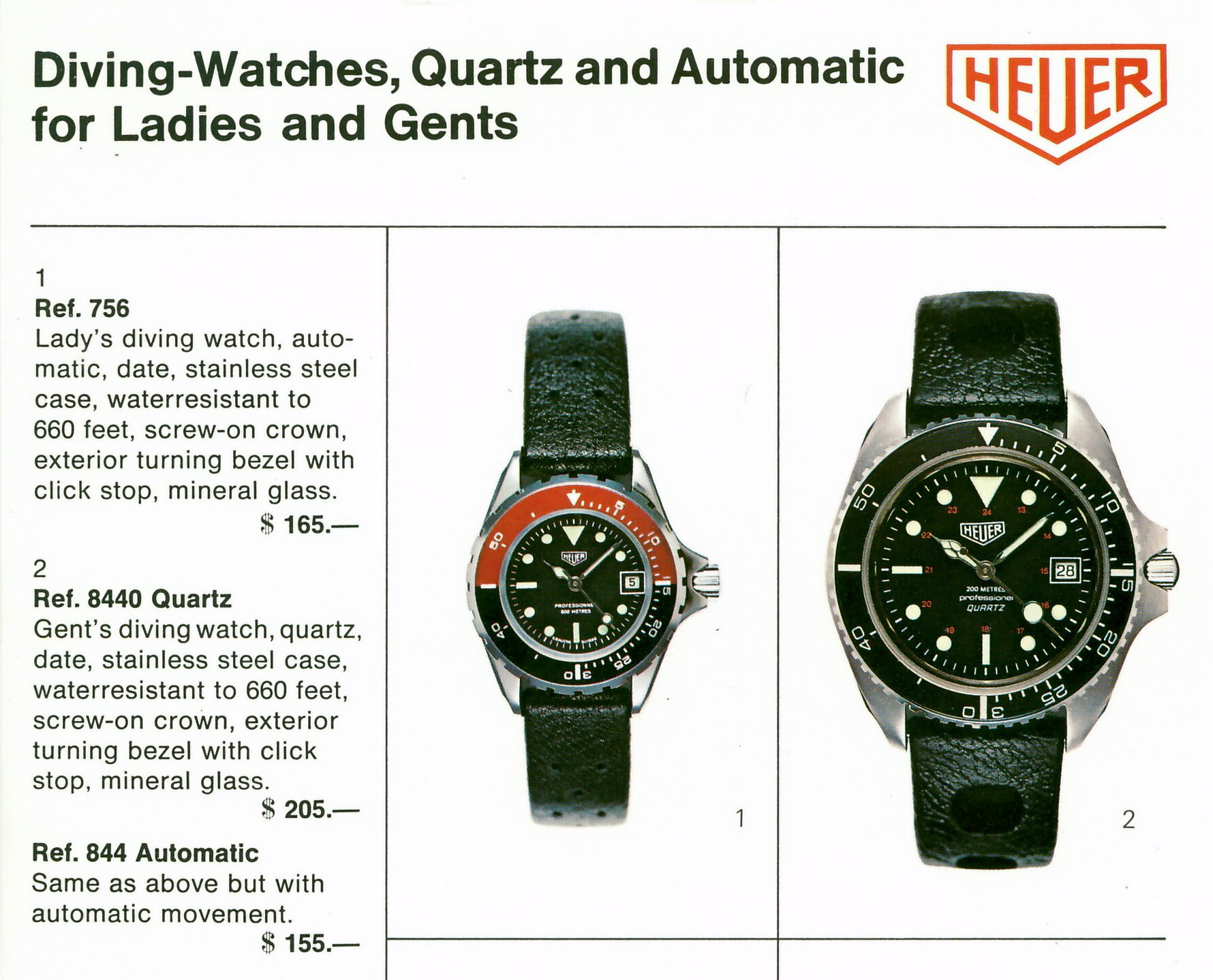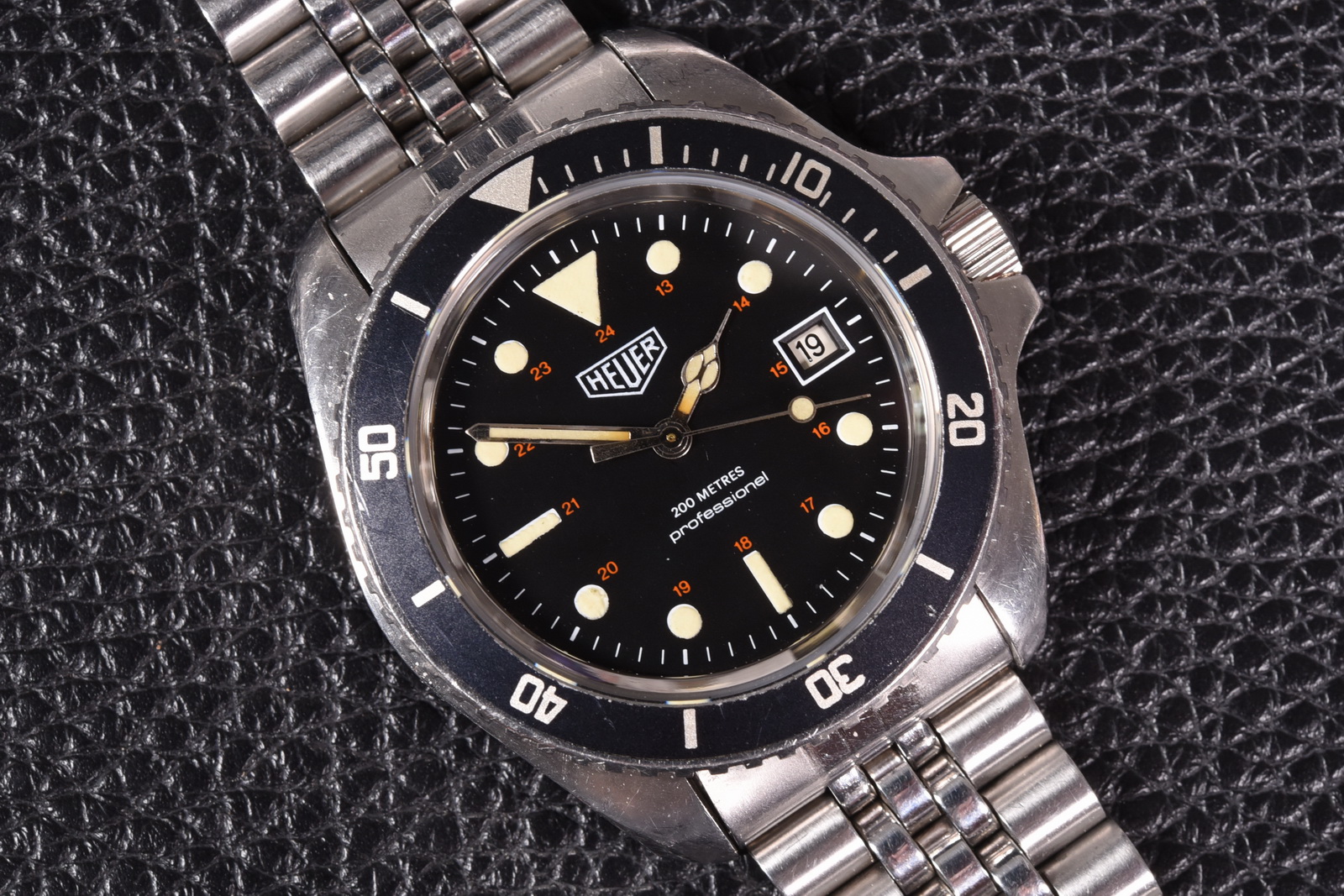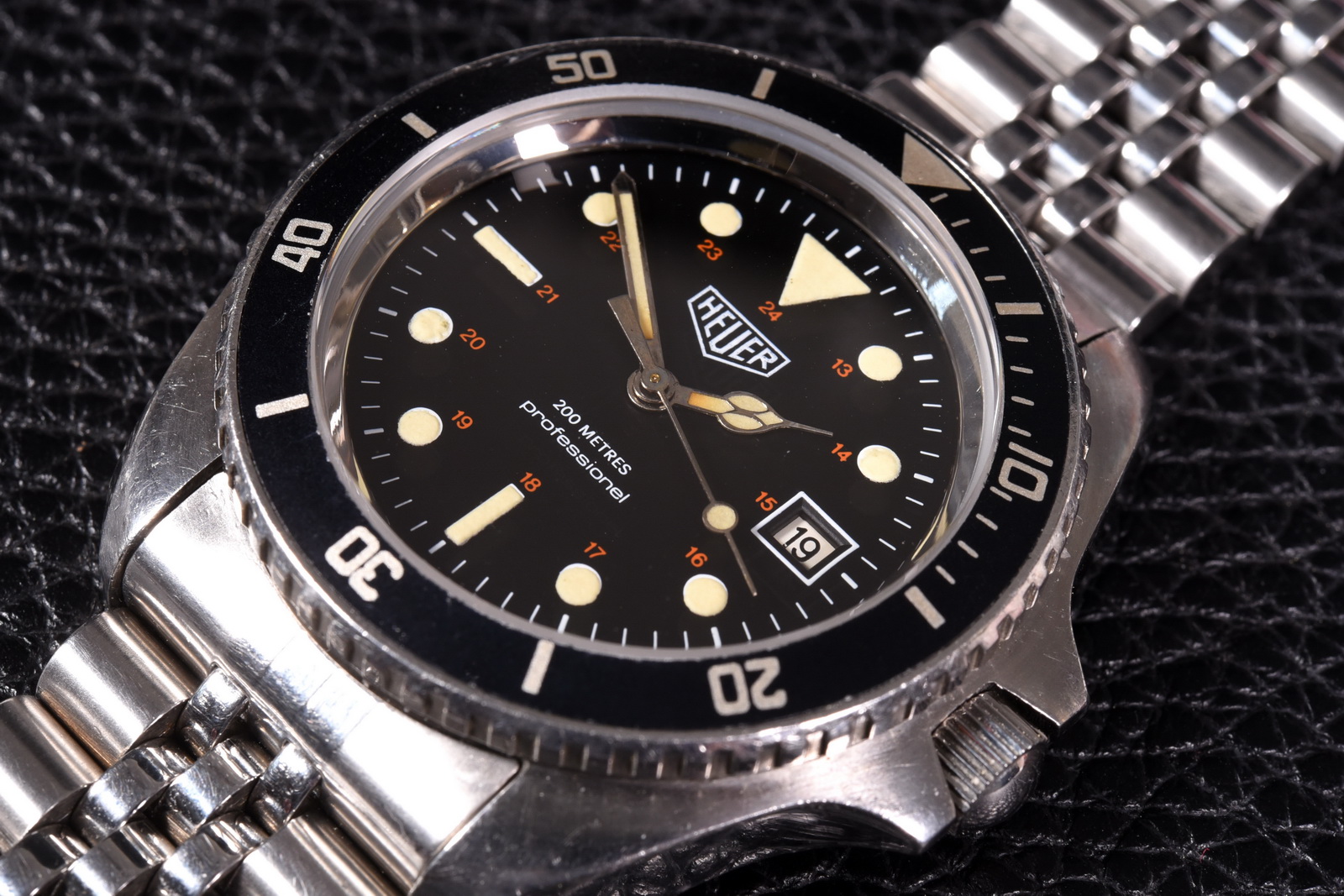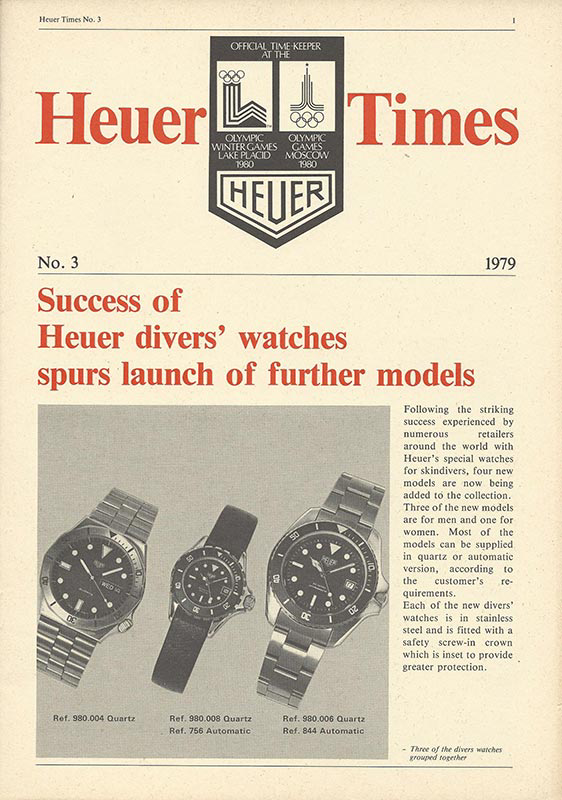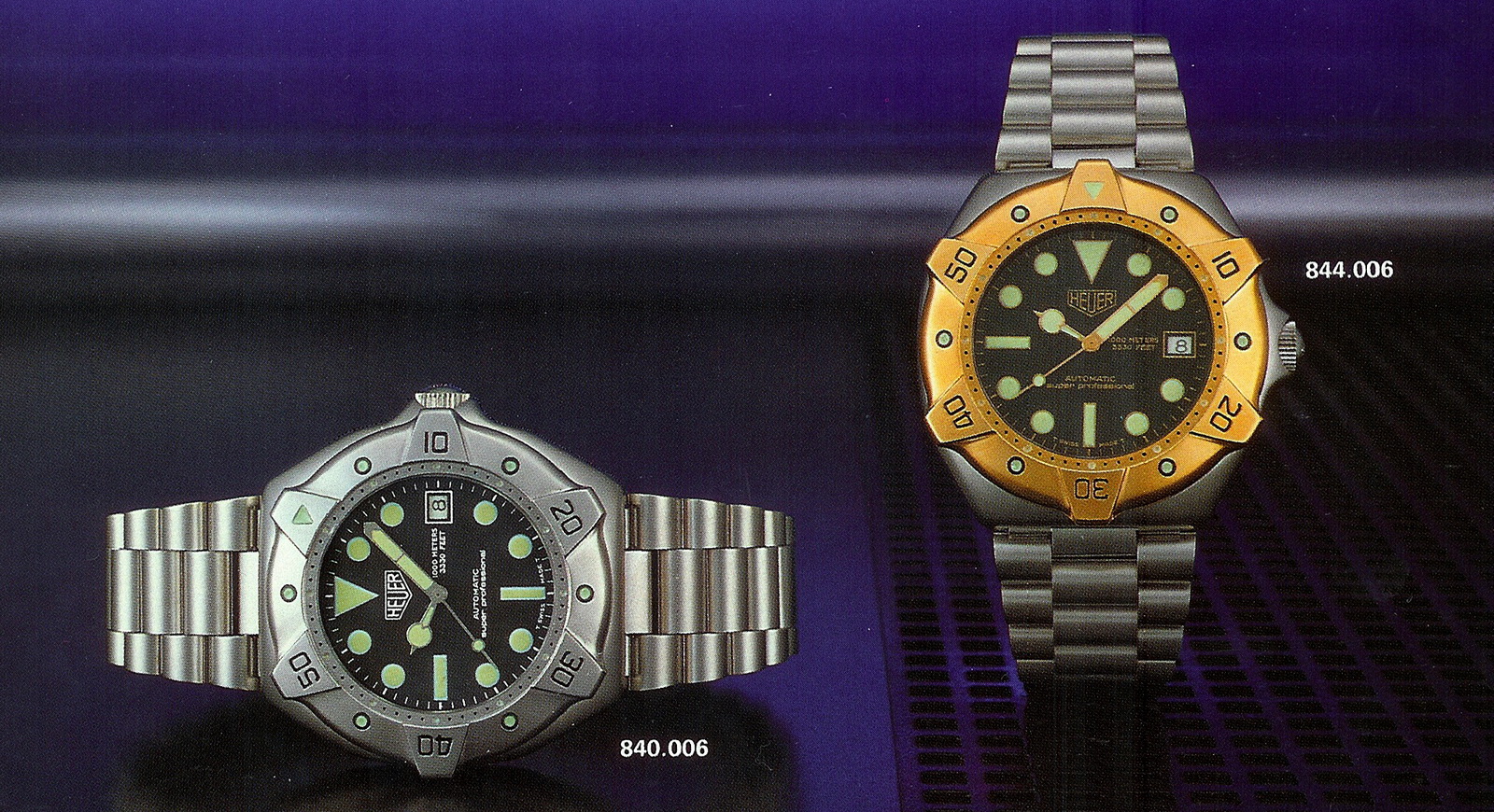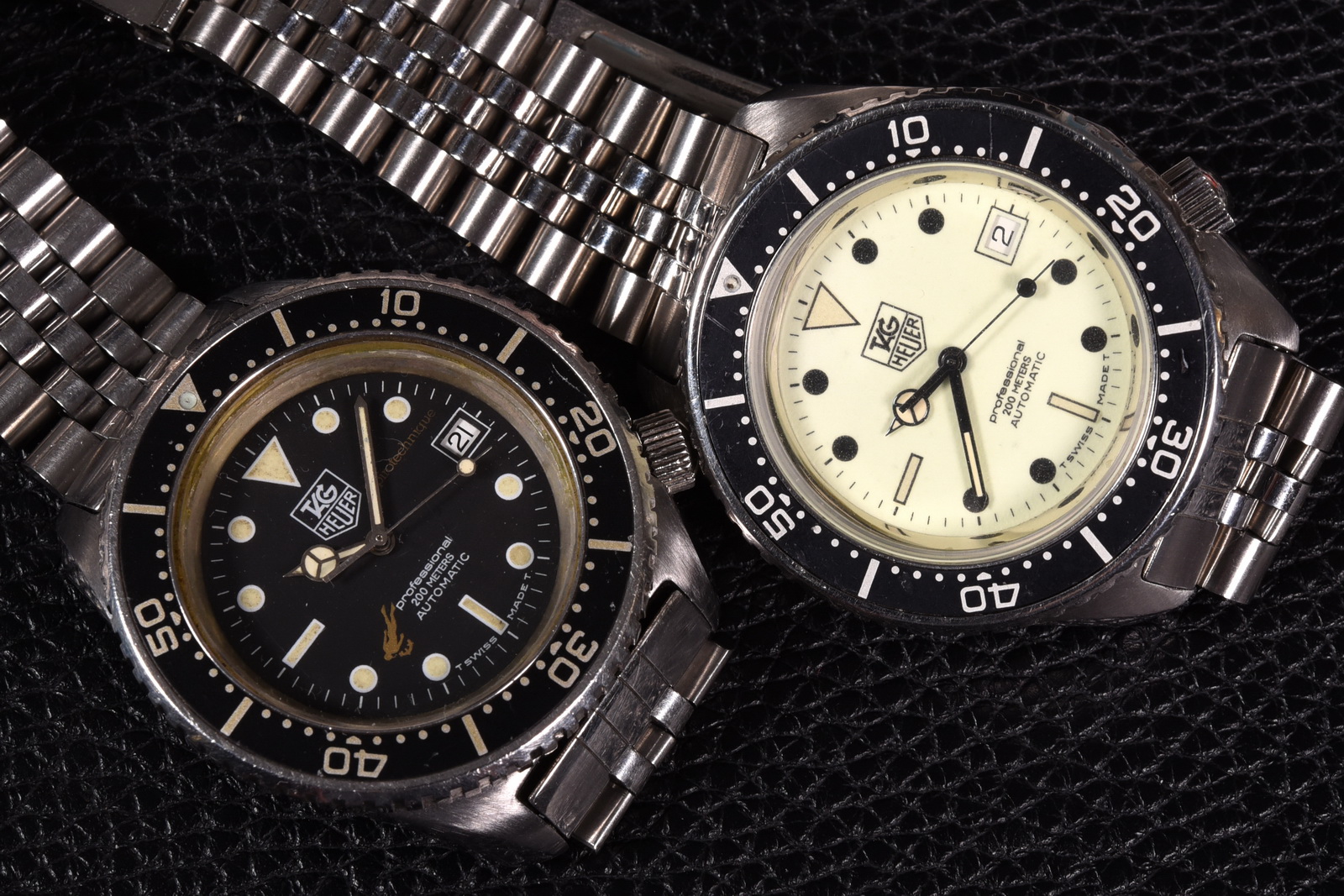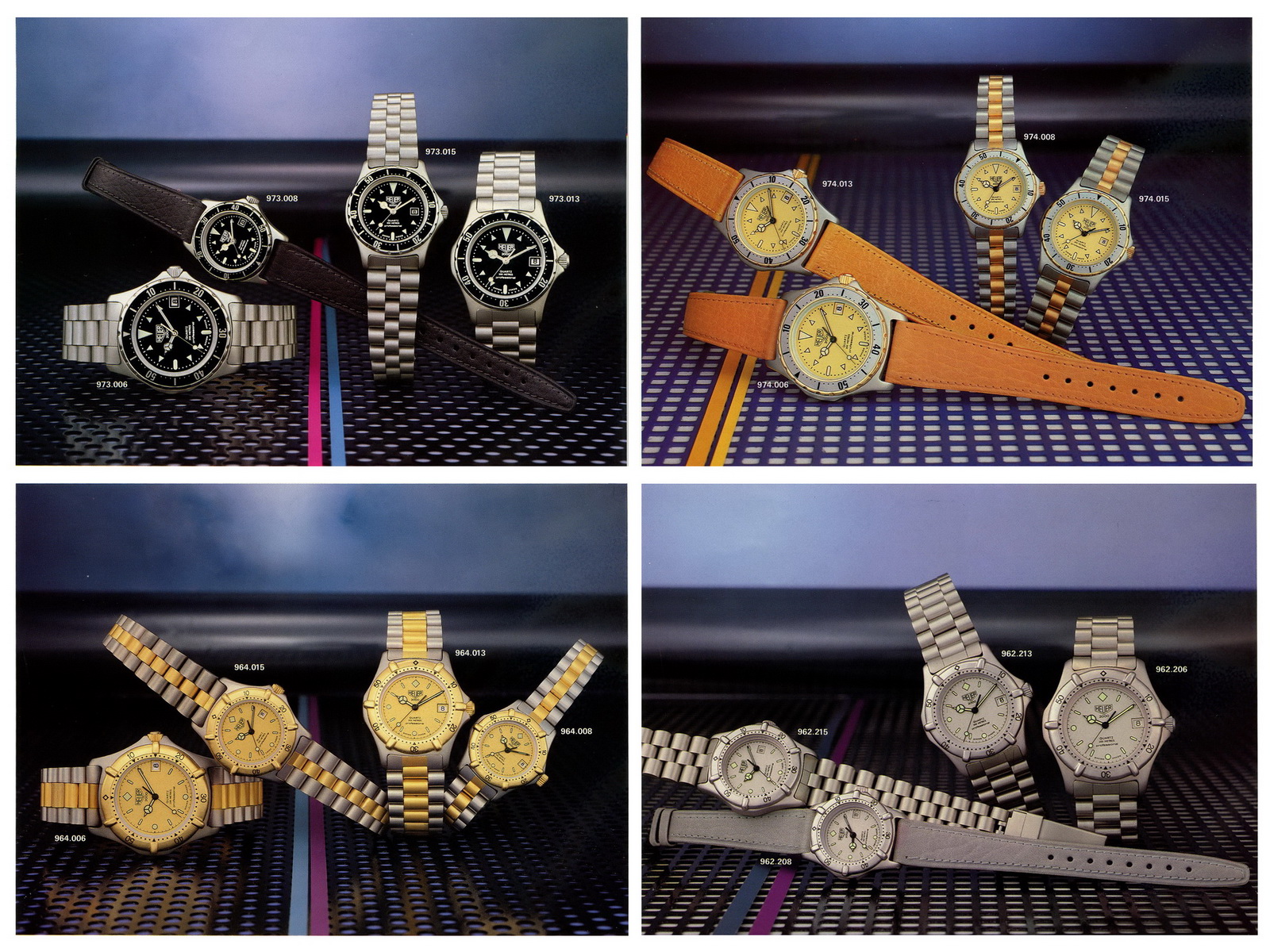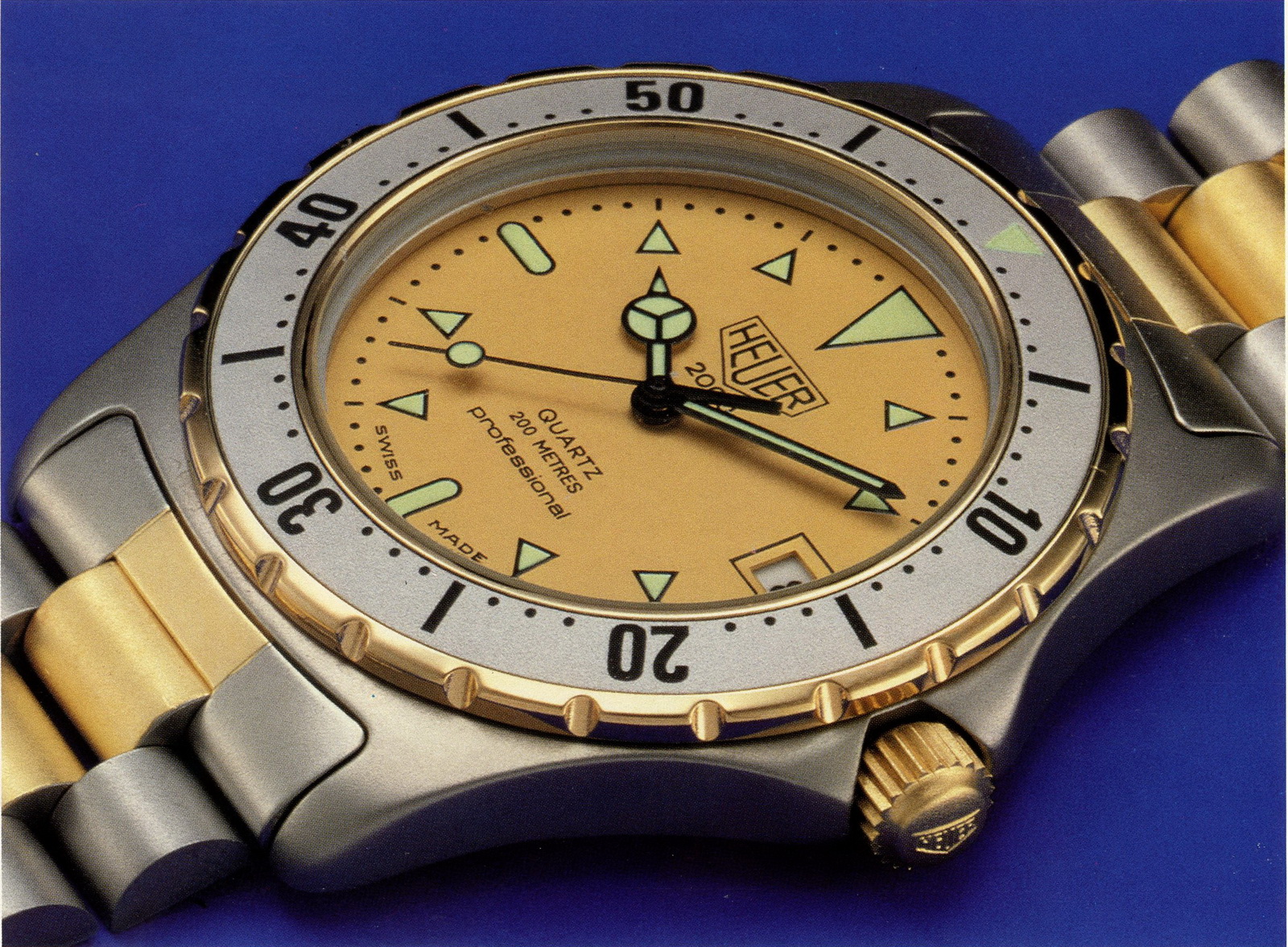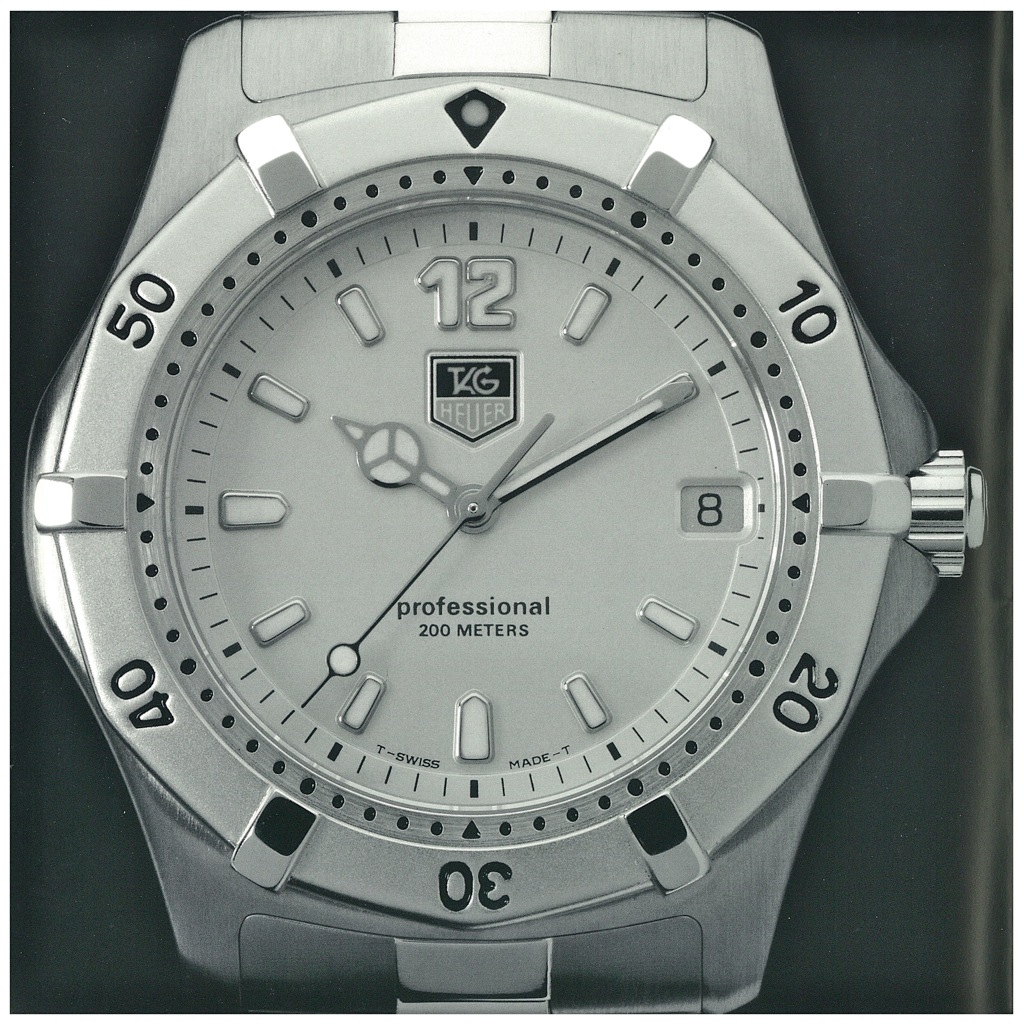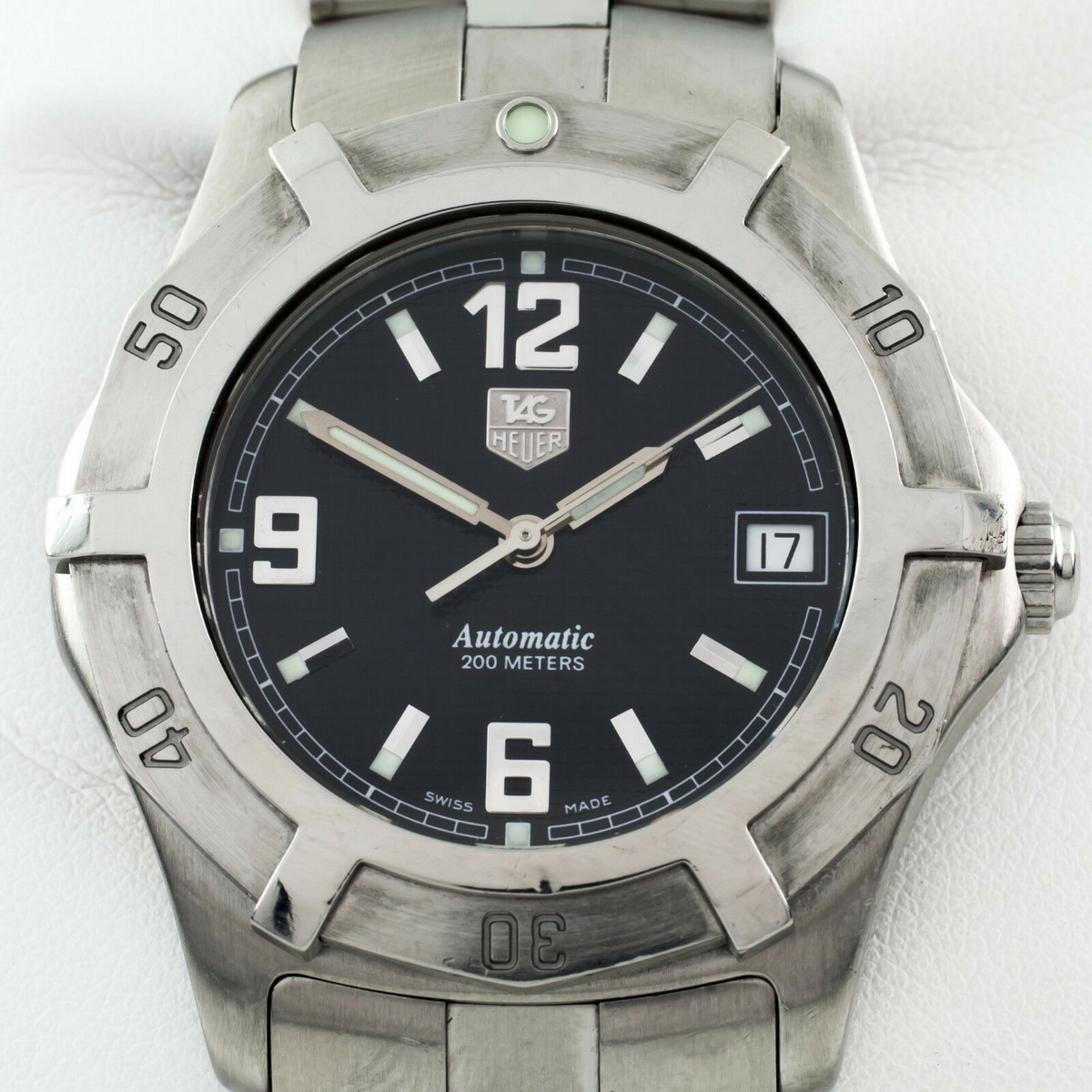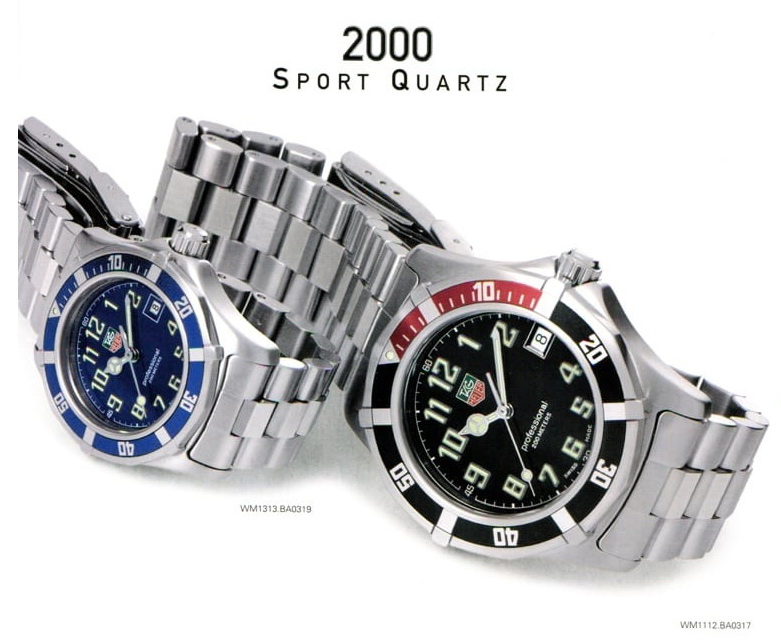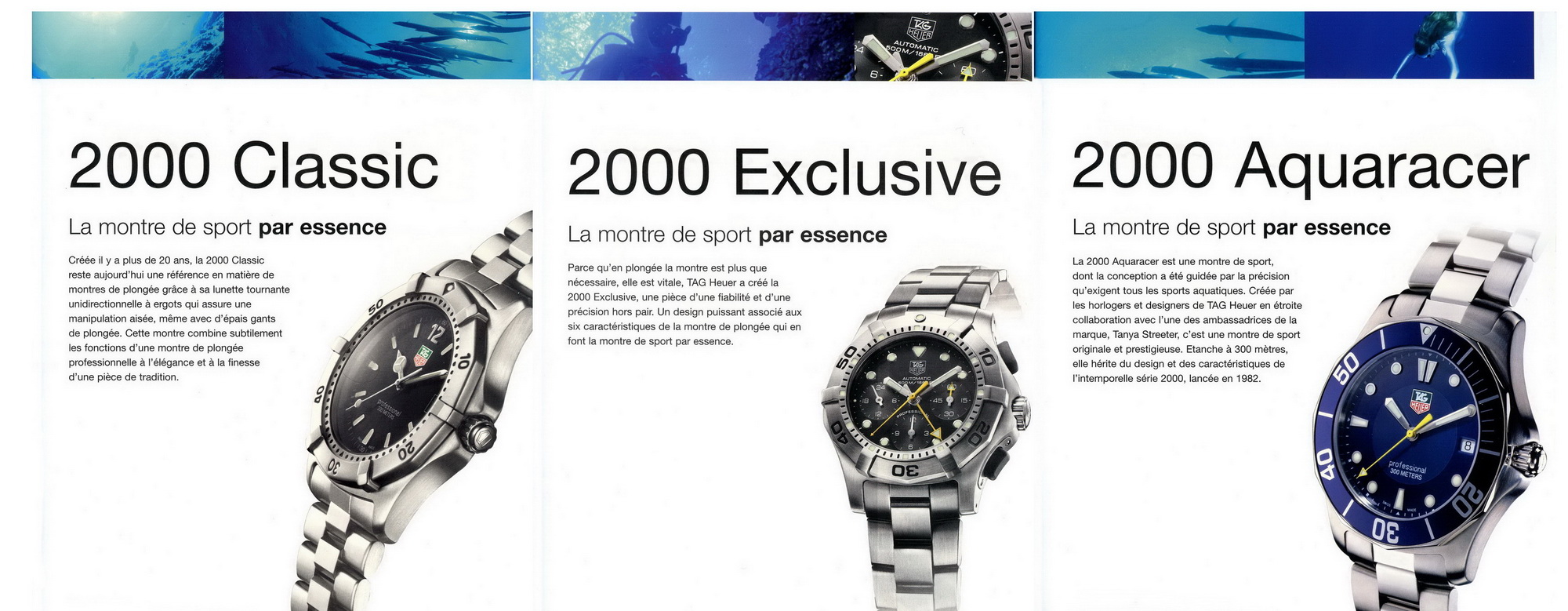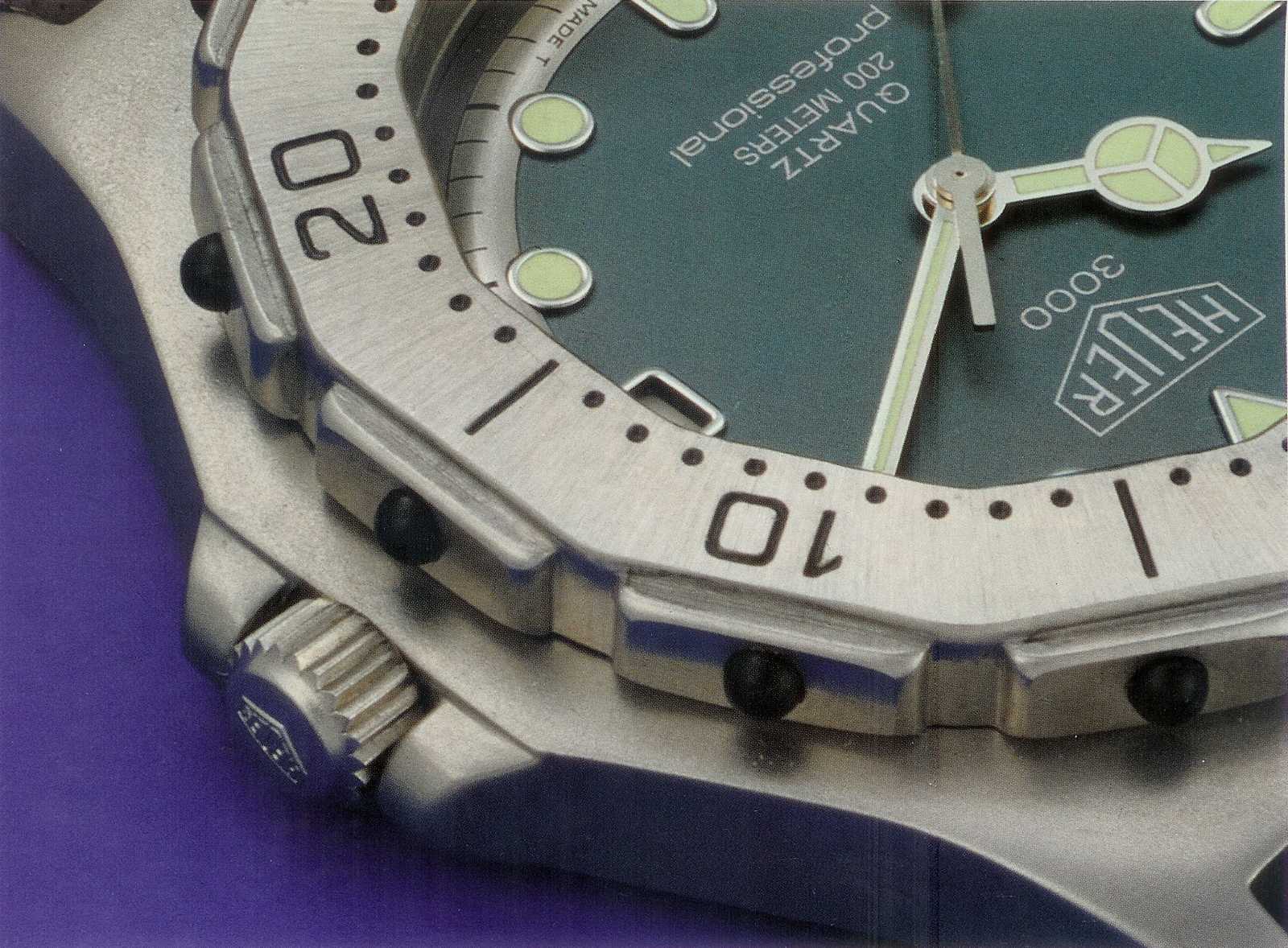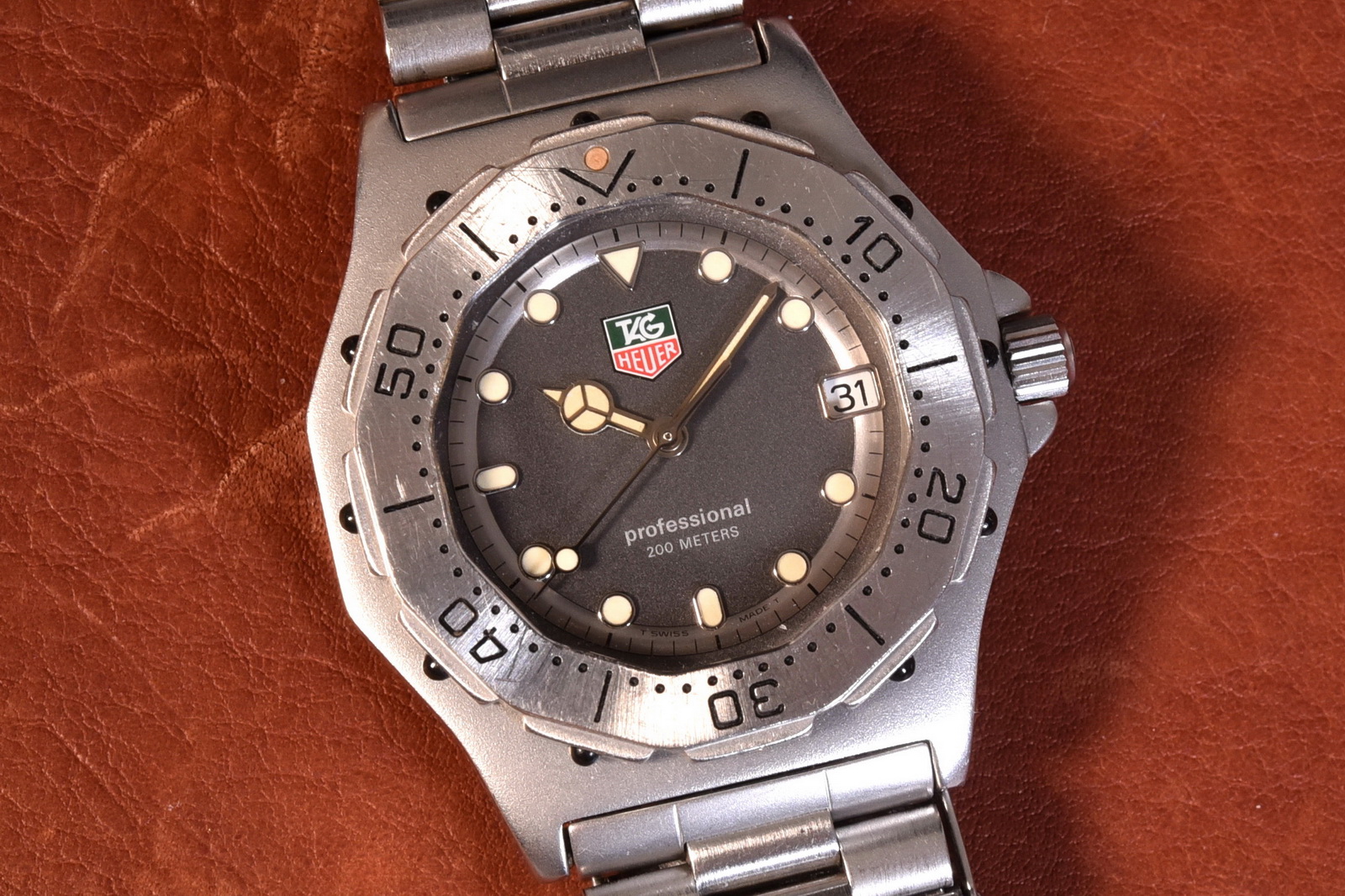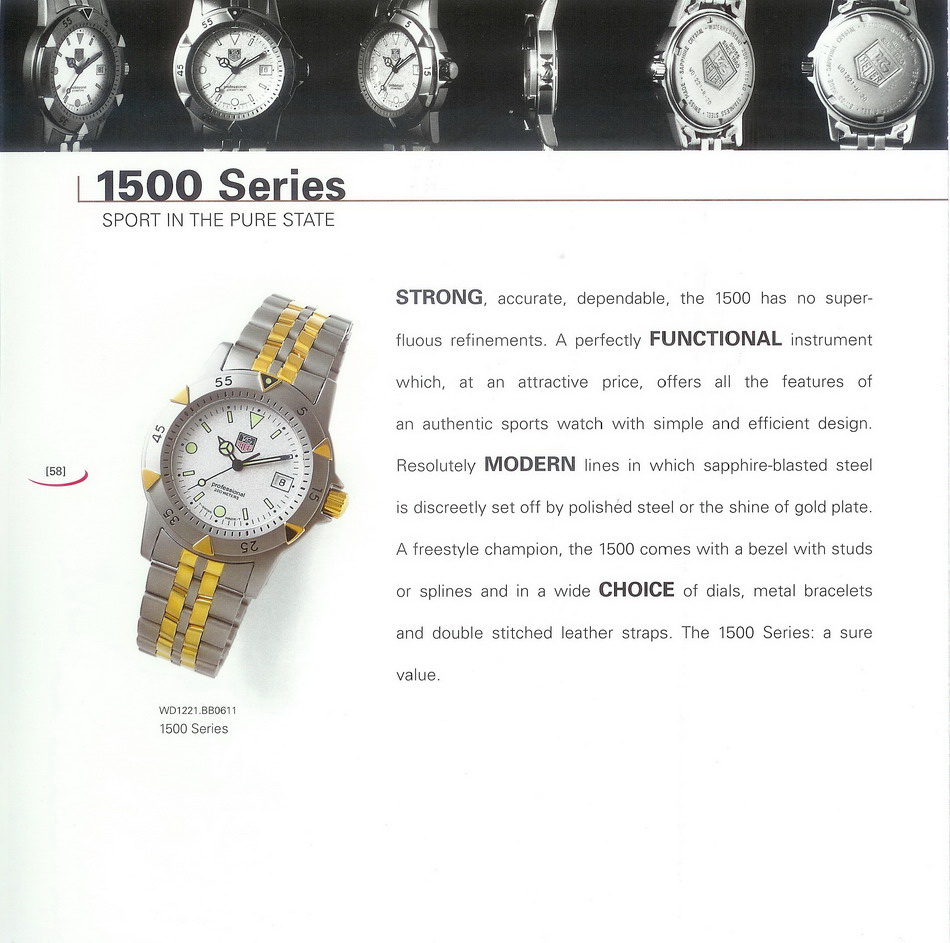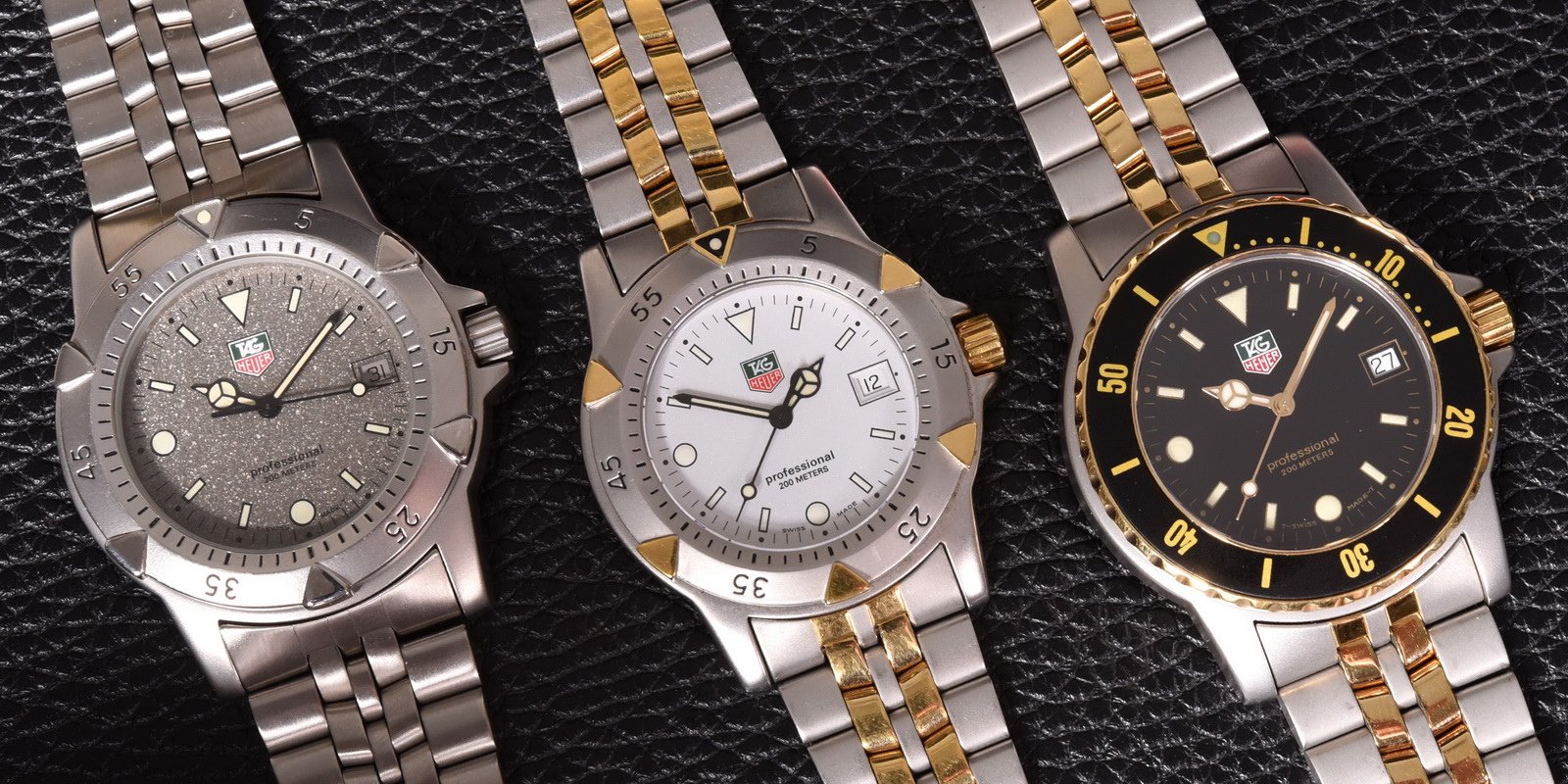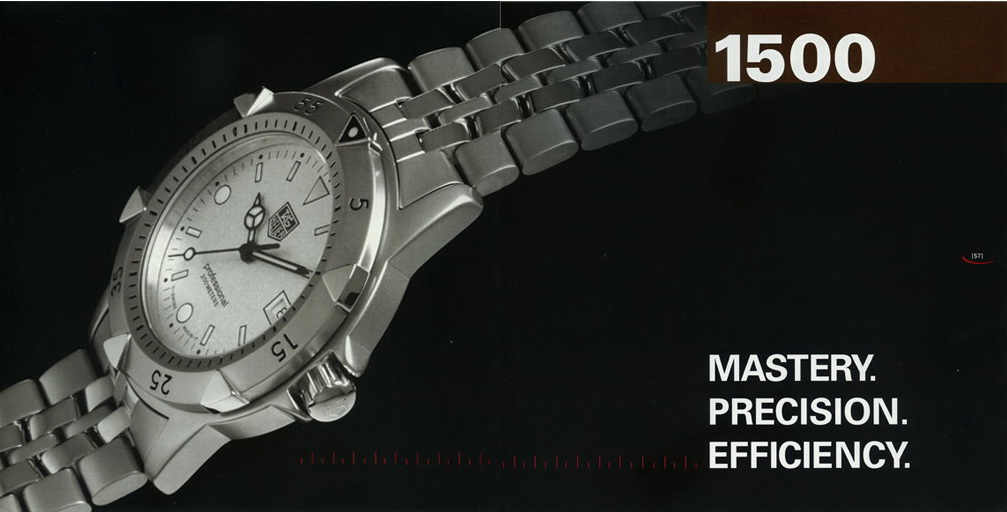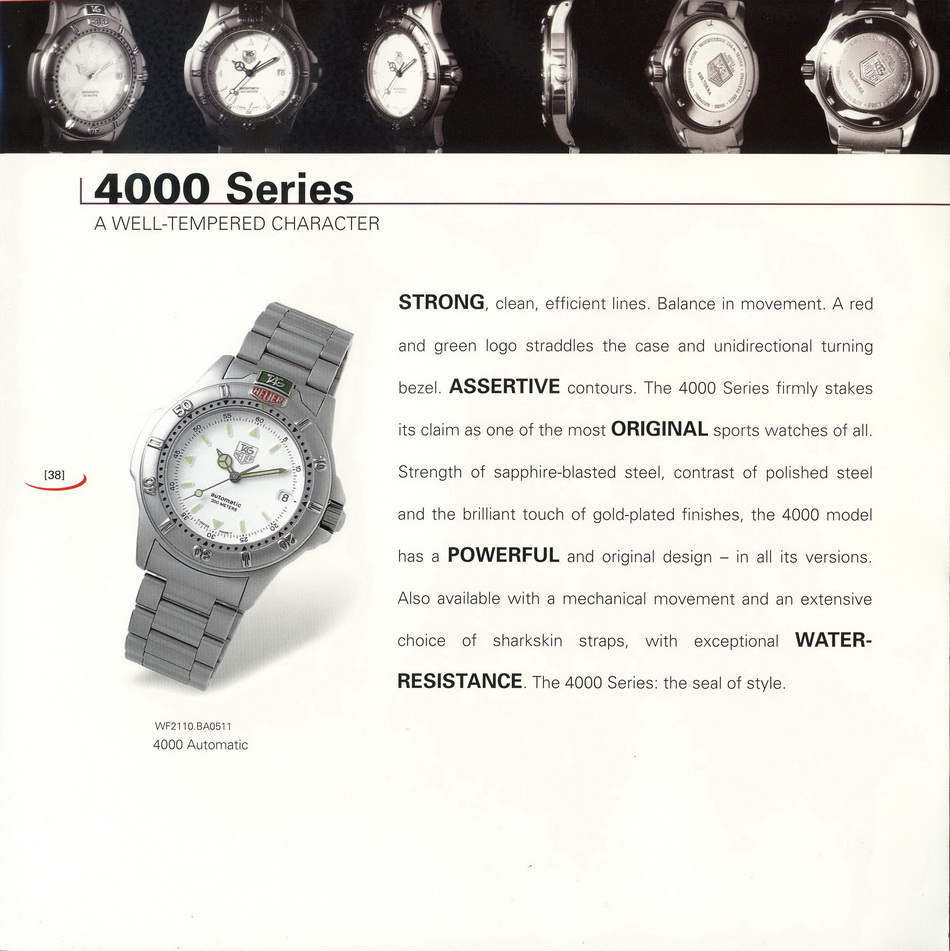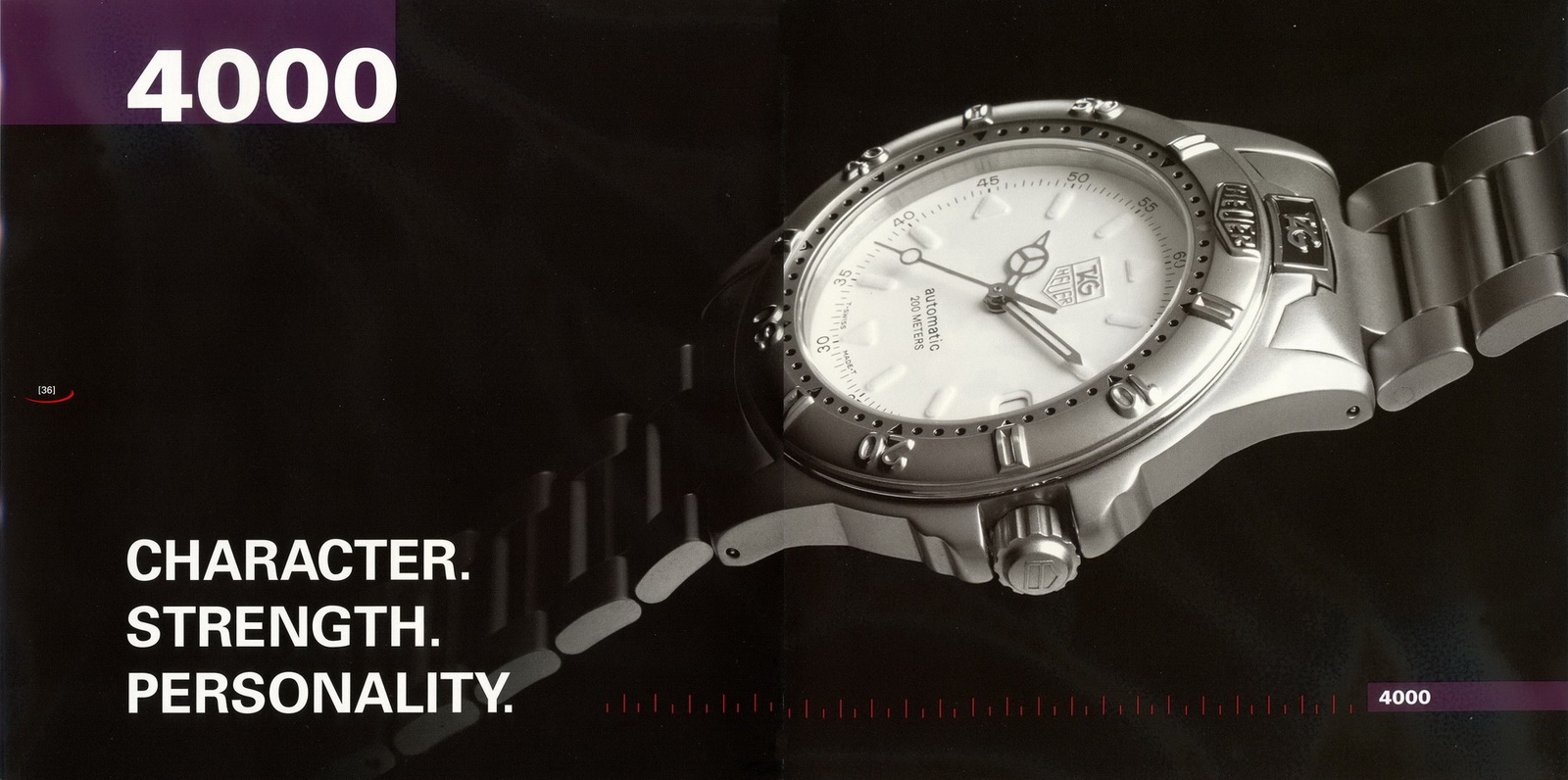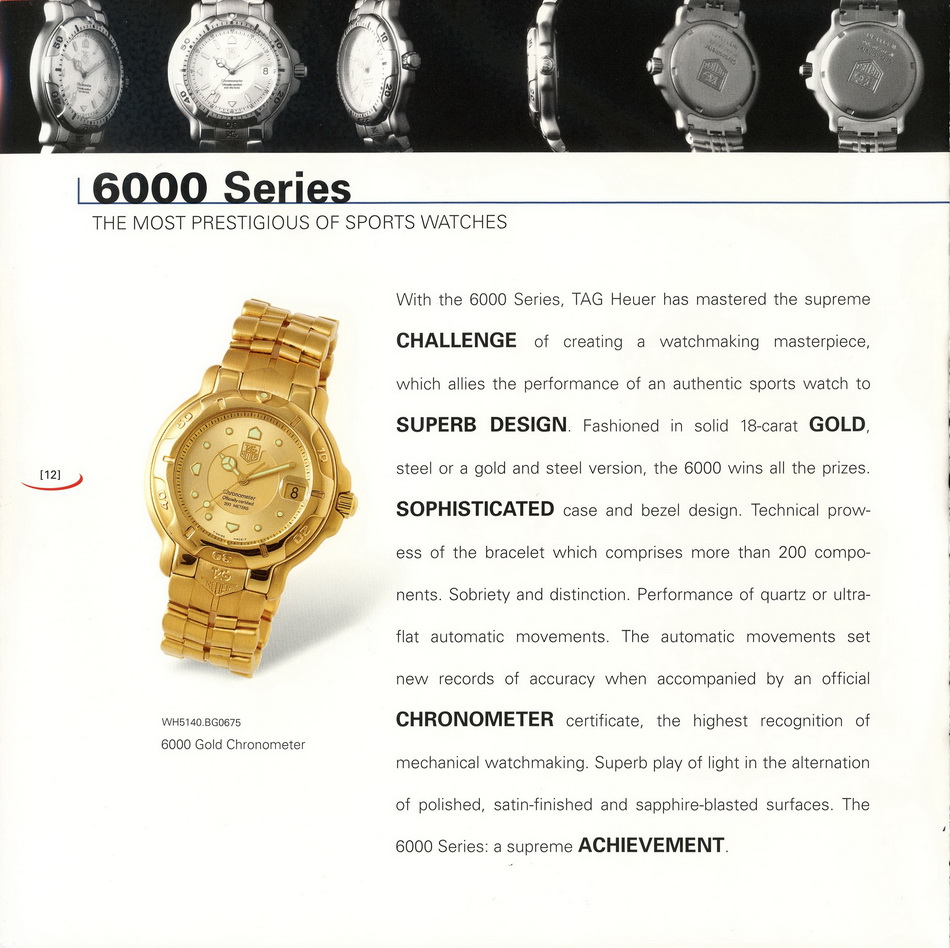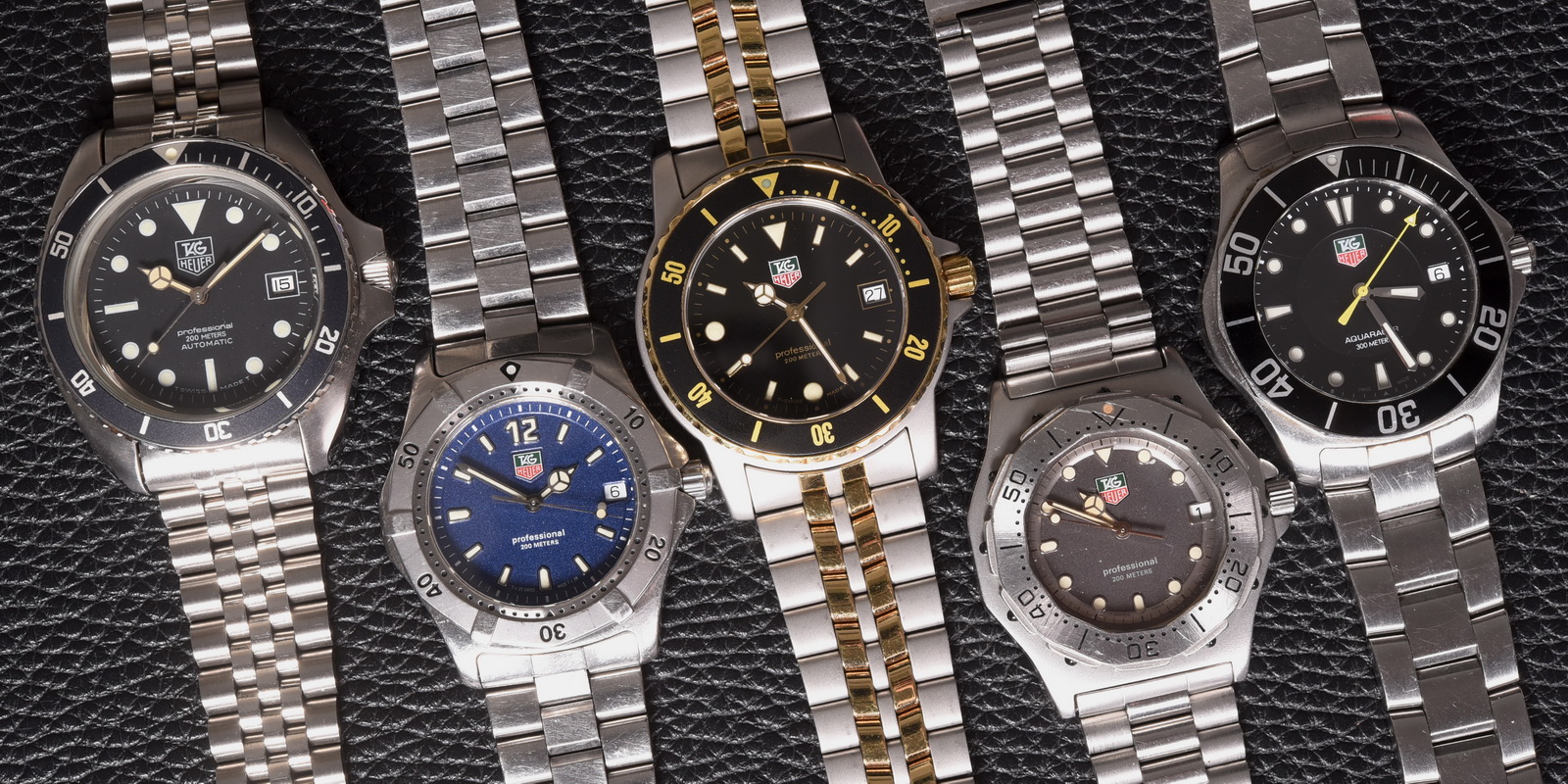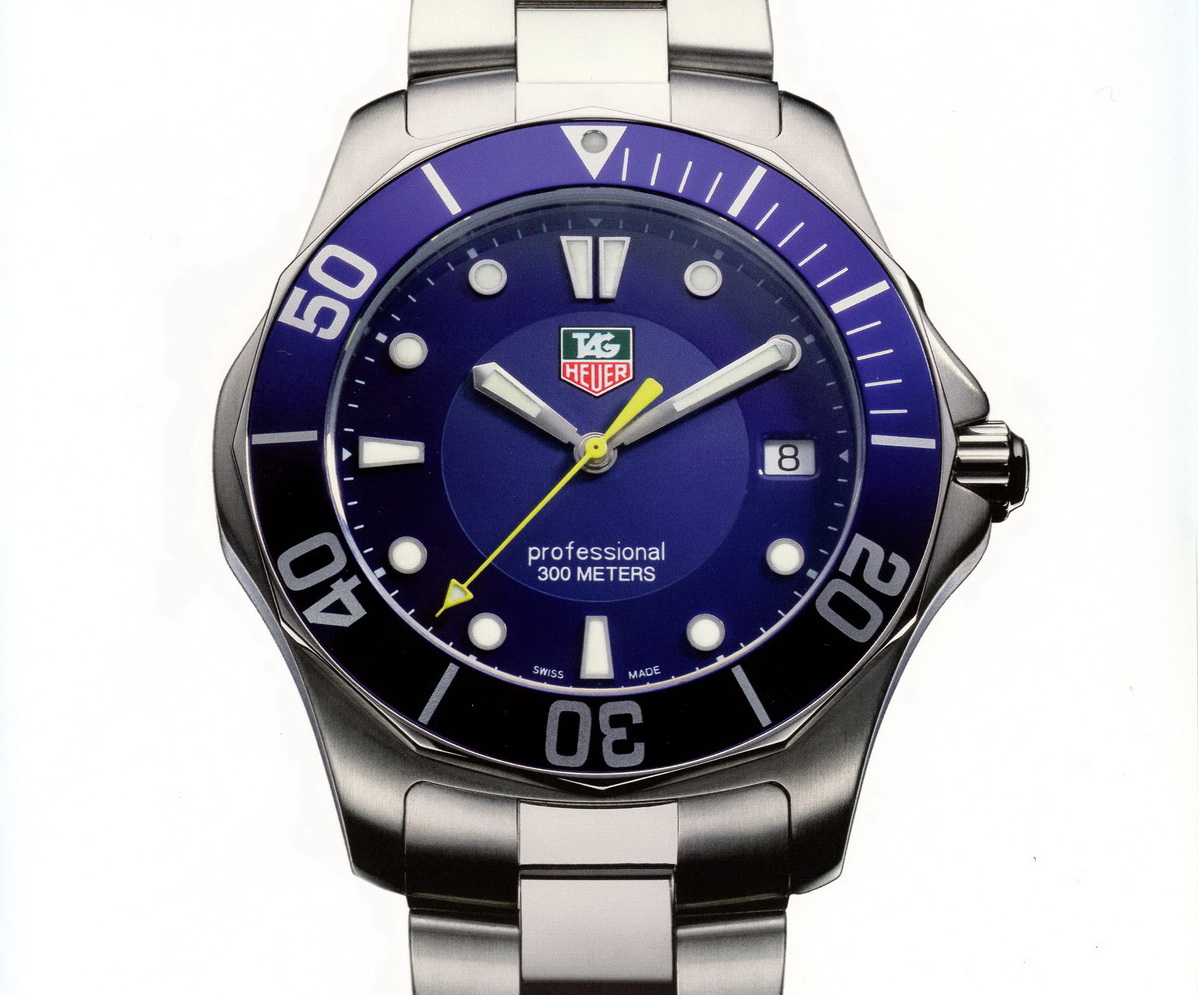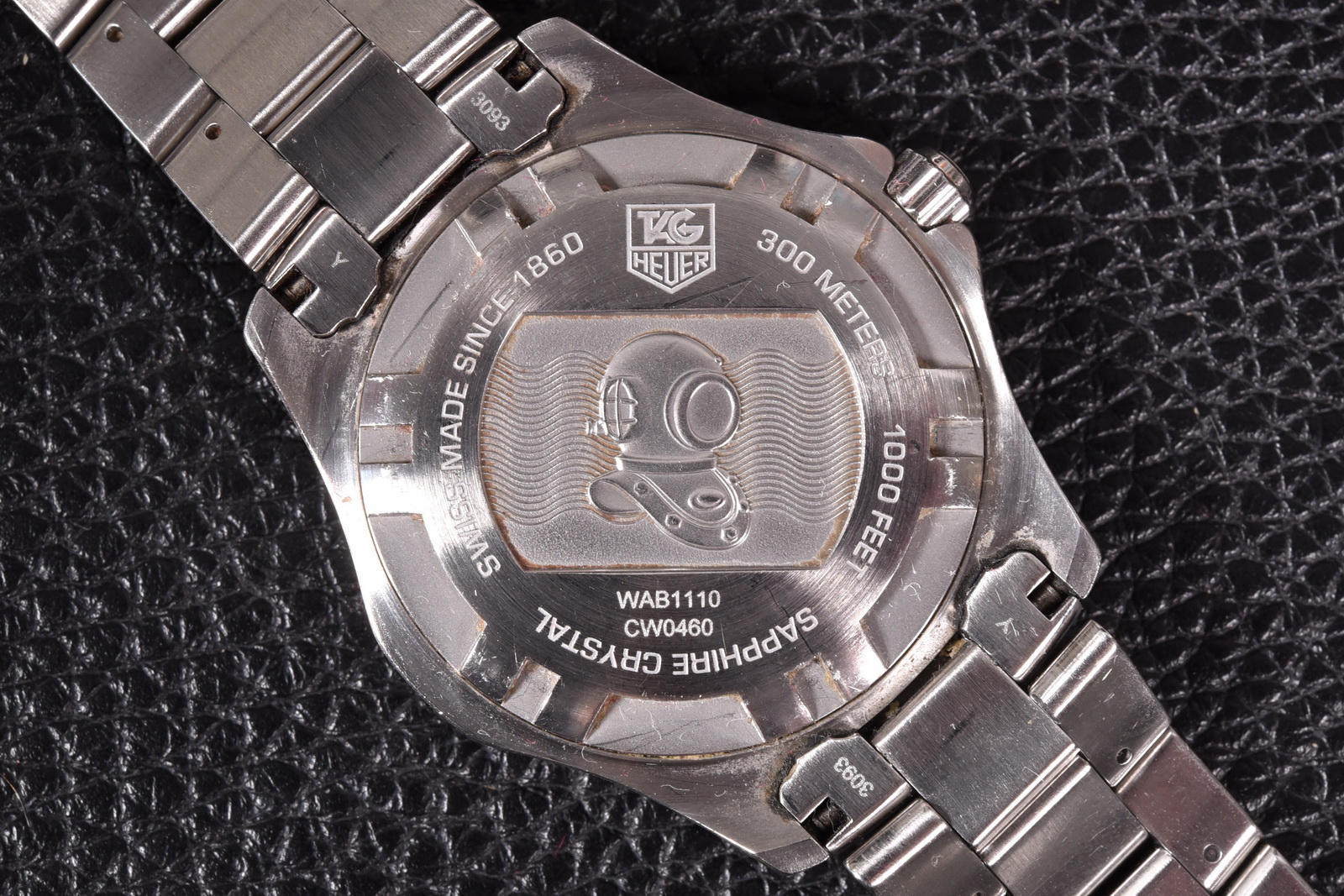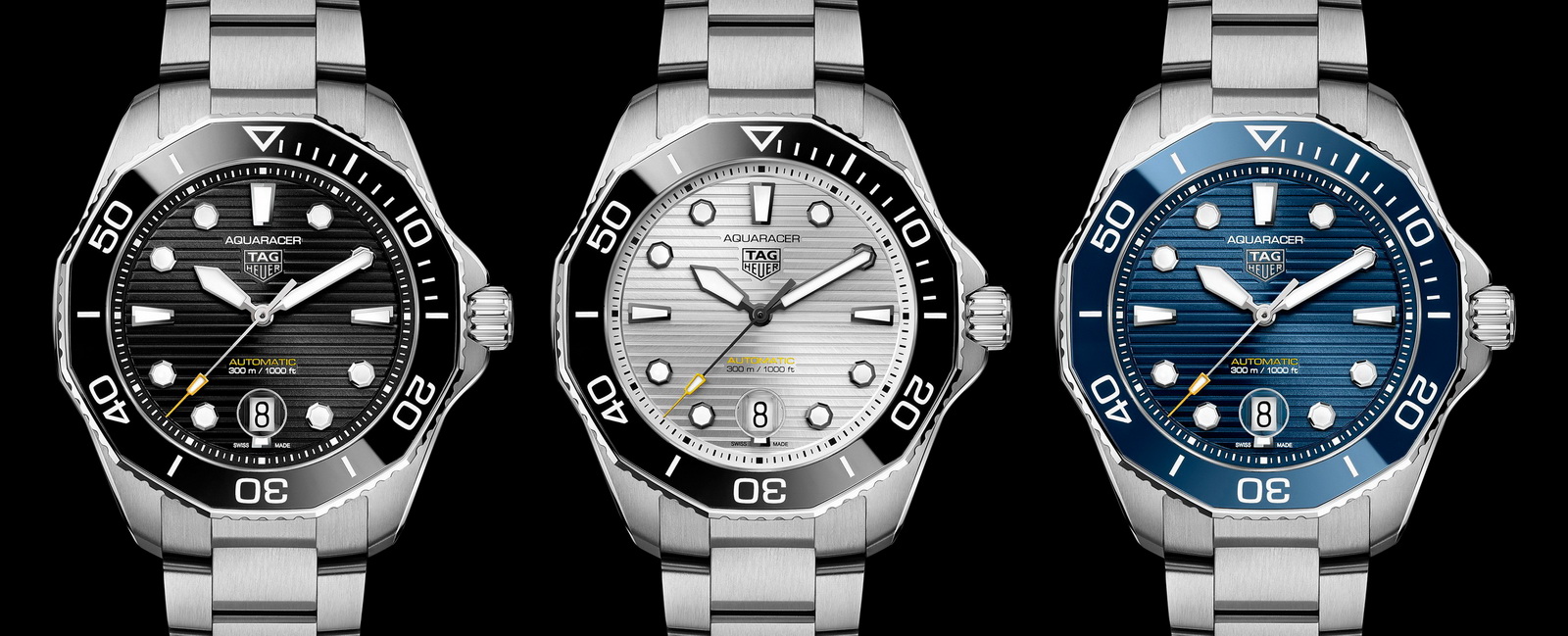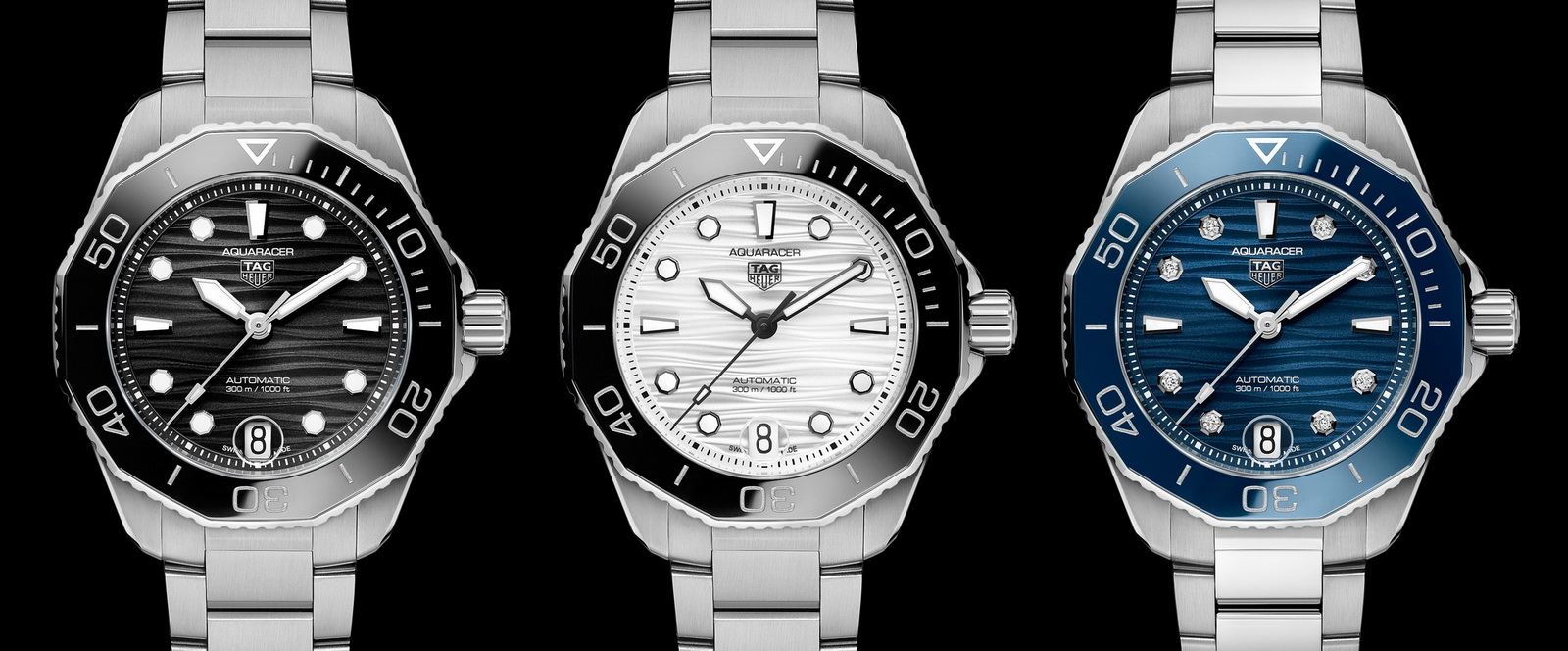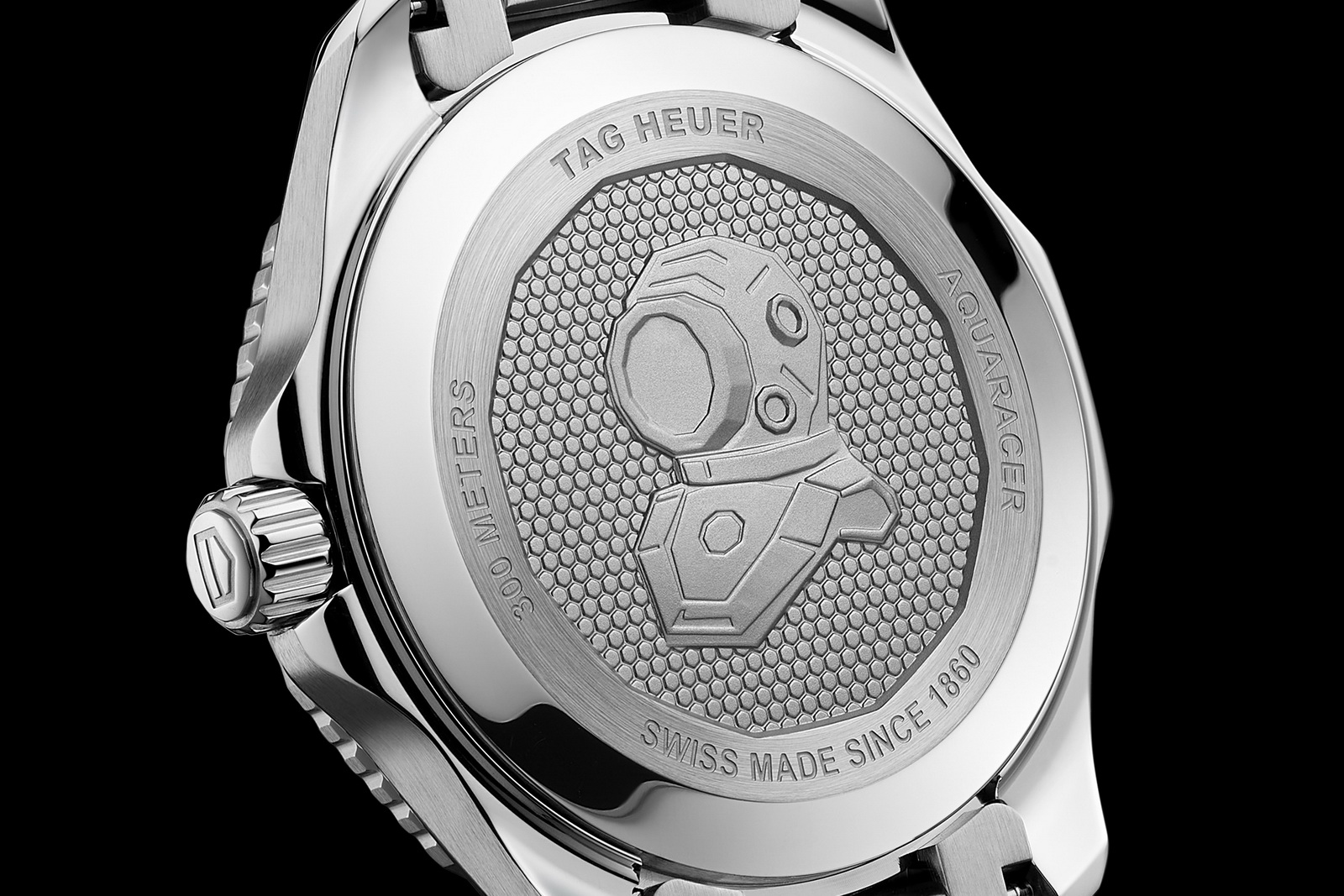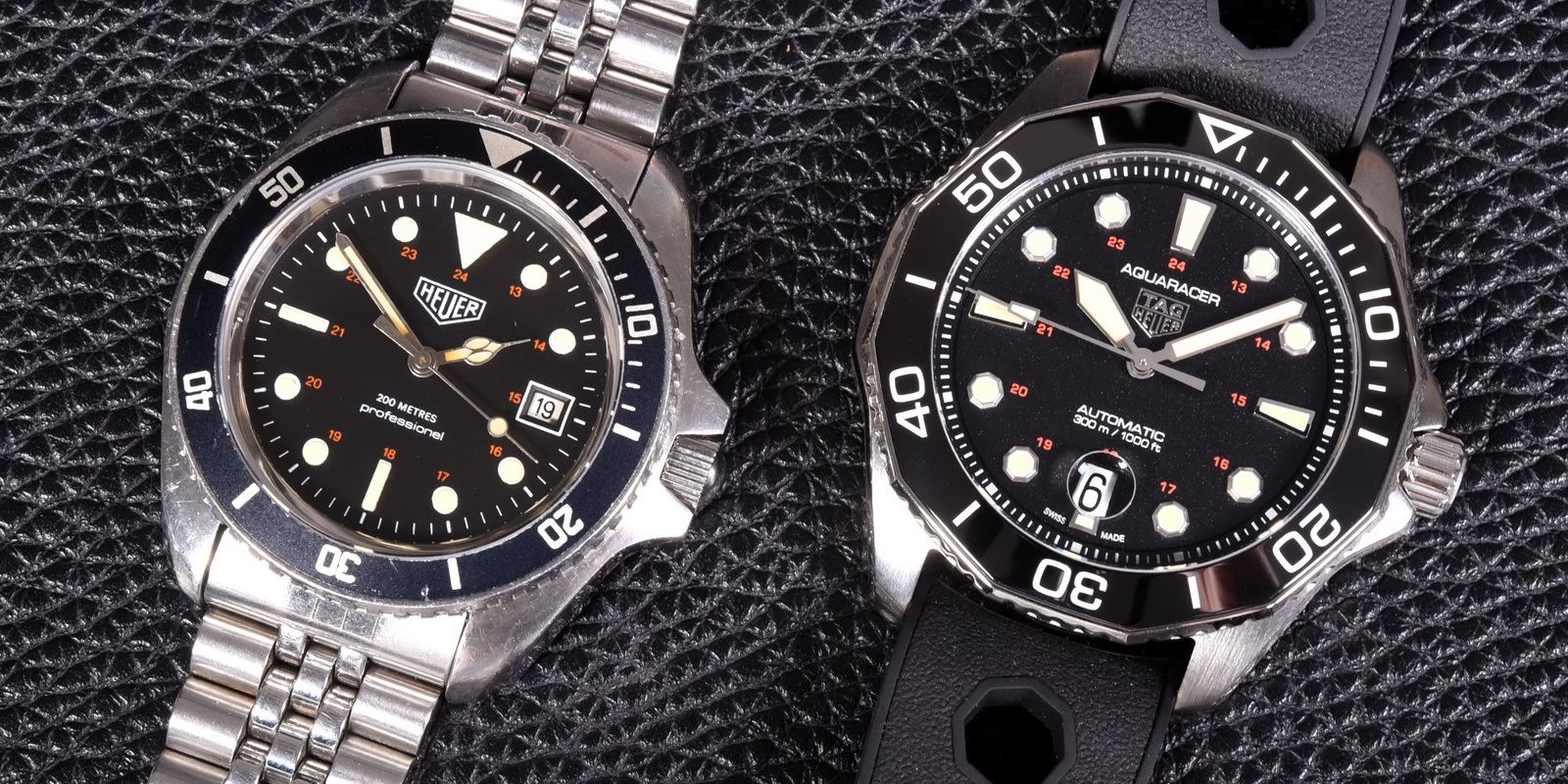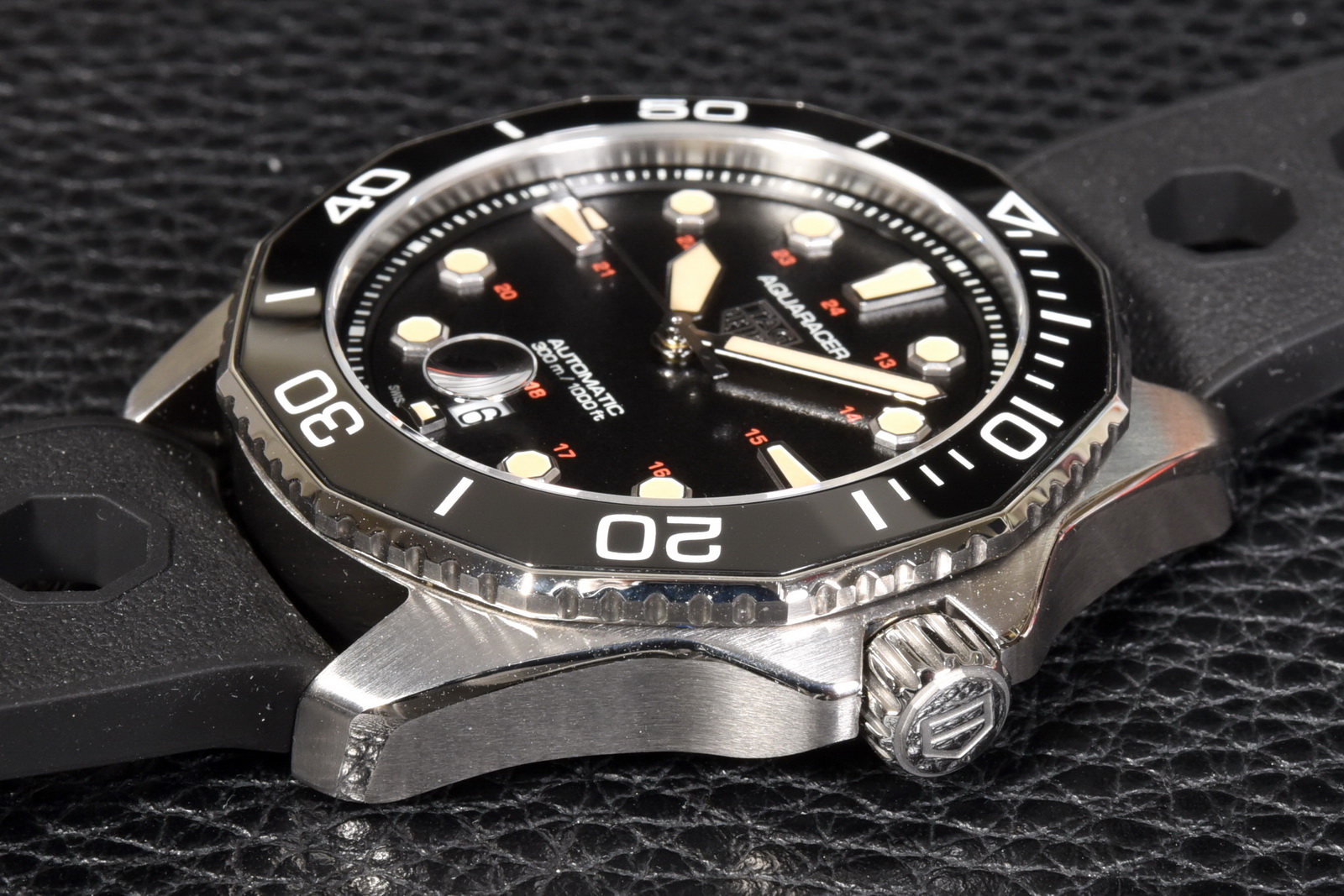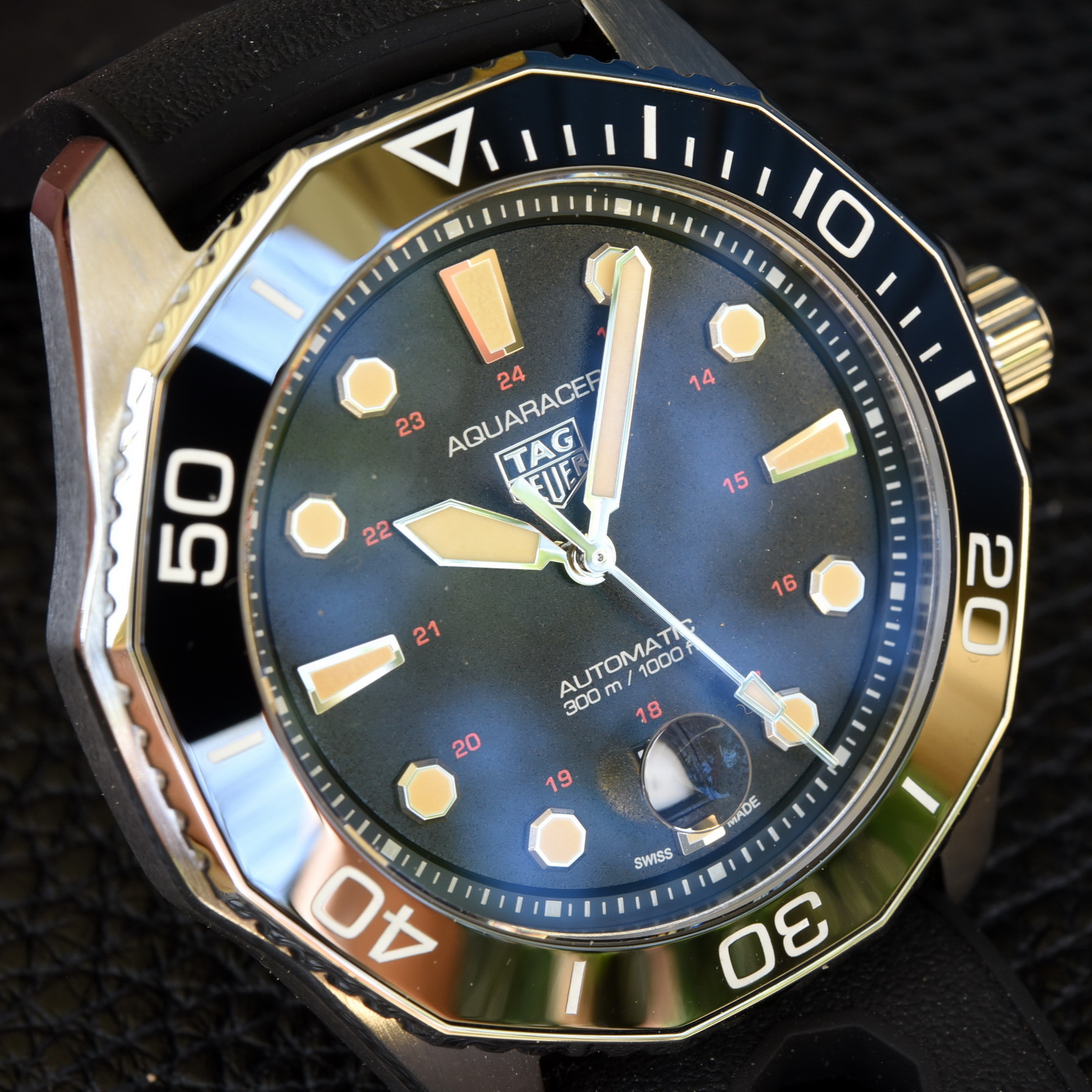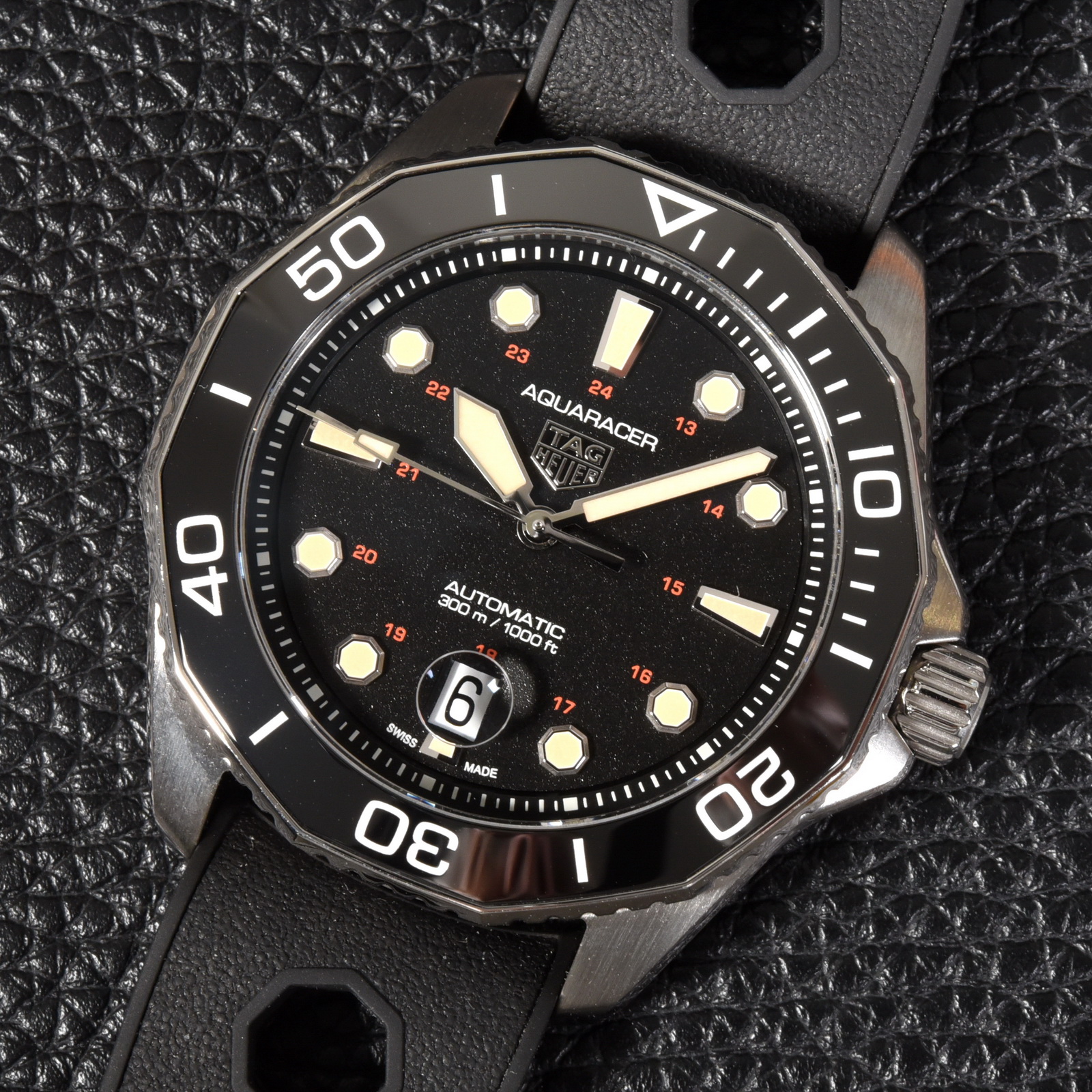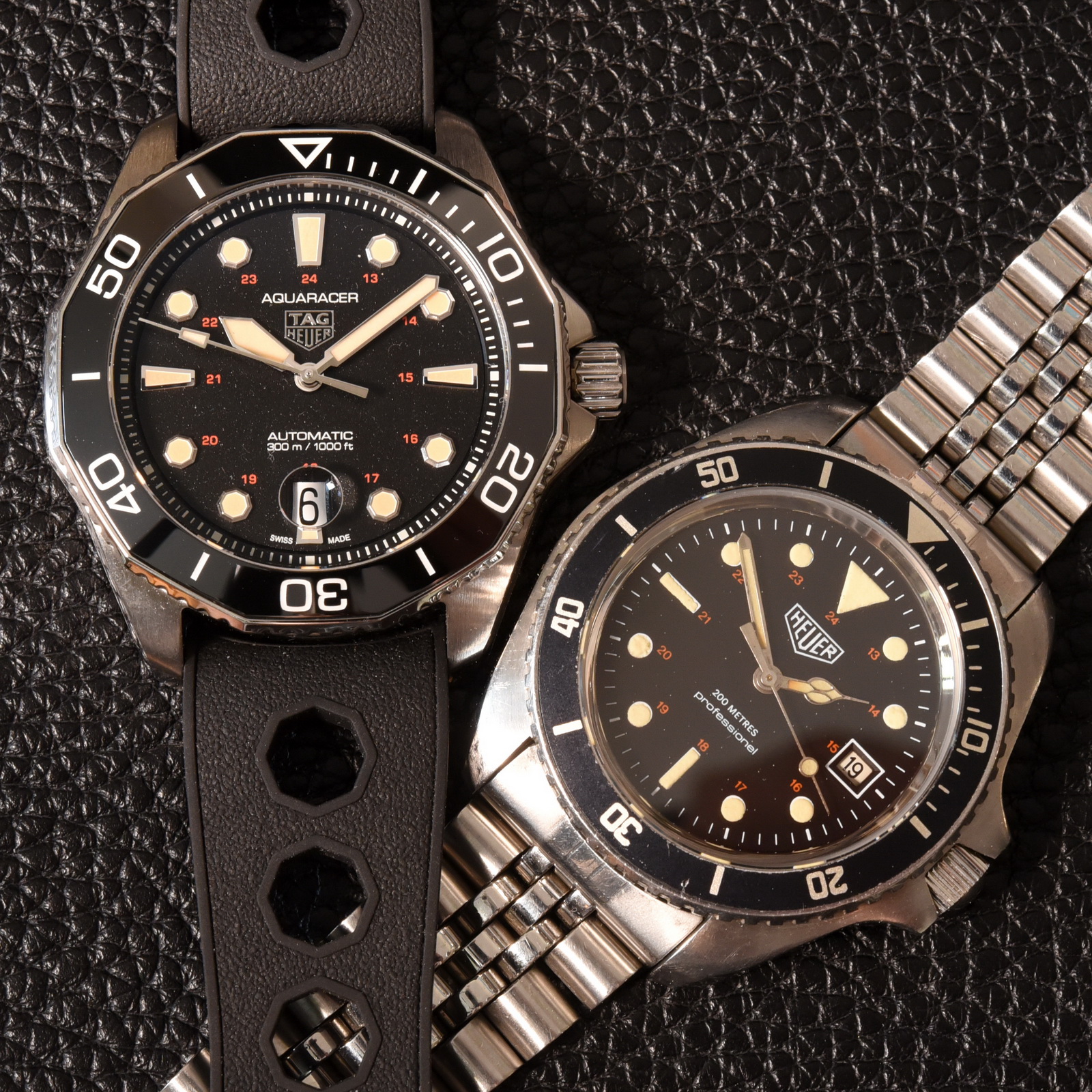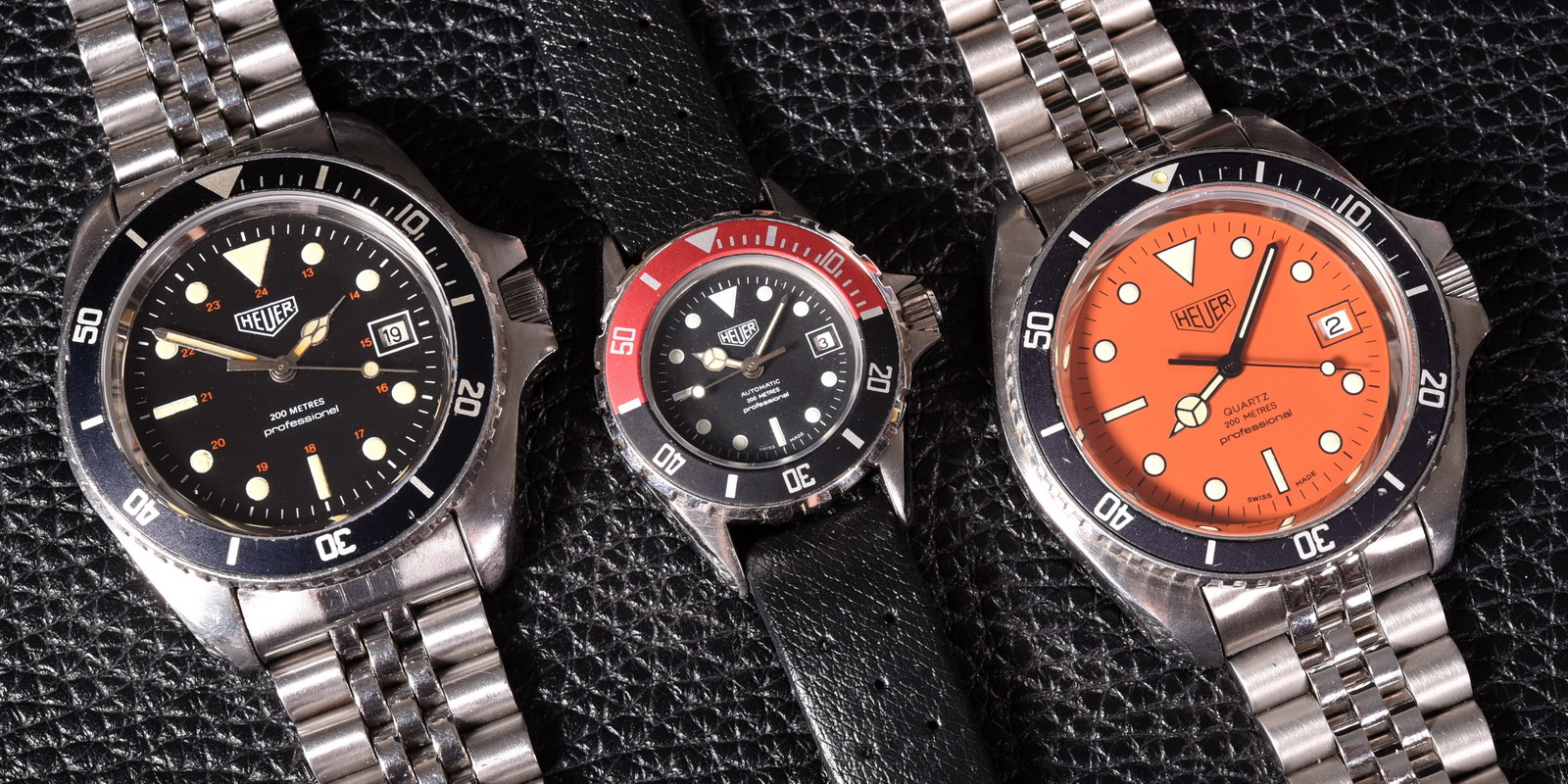I have been collecting Heuer timepieces for almost 20 years, but must confess that there is one branch of the Heuer / TAG Heuer family tree that I have never fully appreciated and, consequently, has been underrepresented in my collection. It’s all these dive watches that began appearing in the late 1970s — the 1000 Series, then the 2000 Series, then – oddly enough — back to the 1500 Series, then the 3000, 4000 and 6000 Series, but for some reason, there never was a 5000 series.
As I think back about this collecting hobby, there are several reasons why I avoided this generation of watches. My collecting focuses on chronographs, and the dive watches have only three hands. I chase the chronographs with mechanical movements, but TAG Heuer’s dive watches of the 1980s and 1990s were battery powered.
Another thing that kept me away from these watches is my confusion about the various collections and models. The different Series — 1000, 2000, 3000, etc. — sound straightforward, but these names are not typically marked on either the dial or back of the watches. We are left with confusing reference numbers, and to make things even more confusing the style of the reference numbers changed around 1990, with models previously identified by six numbers (123.456) now having two or three letters followed by four numerals (for example, AB1234). It gets more difficult when we try to figure out models such as the “Deep Dives” and the “Super Professionals”, which do not fit neatly into one of the “Series” collections.
For today’s collectors, TAG Heuer dive watches from the 1980s and 1990s seem to be everywhere. On a given day, there are hundreds (or even thousands thousands) of them listed for sale on eBay. These are the watches that “everyone” wore in the 1980s and 1990s. They seem to have been popular as graduation gifts or as the professional’s “first real watch.”
We see them on the wrists of prominent people, from Barack Obama to Bill Gates.
Movie fans will find Heuer dive watches on the wrists of James Bond (wearing a Reference 980.031 in The Living Daylights) and Bo Derek (Reference 756 in Penthouse, for example). They are just about ubiquitous, which contributes to the difficulty of figuring out which watch is which and collecting them.
To my eye, the TAG Heuer dive watches are attractive. They are available in a variety of sizes and colors; you can choose a three-hand watch or a chronograph; movements can be automatic or quartz-powered. They run well and parts (and watchmakers) can be found when needed. Compared with the Heuer chronographs from the 1960s or 1970s, or the TAG Heuer watches from the 21st century, the dive watches of the 1980s and 1990s are affordable. You can have some nice choices in the $500 to $1,000 range; you can have one of the “grails” for under $4,000.
My aversion to TAG Heuer quartz dive watches began to change in late 2019. I was exploring a couple of Heuer dive watches that Marlon Brando seemed to wear on a regular basis. I bought a Reference 980.021 (part of the 1000 Series, circa 1987) and a Reference 925.206 (part of the 1500 Series, circa 1991). These were a new style of watch for me — bi-metallic, in steel and gold — and both were on their original bracelets. The total investment? Under $1,000.
Then a strange thing happened – I started wearing these two watches on a regular basis and enjoying them. Then it got even stranger – the 1500 Series watch ran for a solid year, gaining less 15 seconds for the 12 months. Yes, it was time to learn at least the “basics” about these dive watches. When was each Series offered by TAG Heuer? How did they evolve over time? Which ones are popular with today’s collectors? You know, asking the same kinds of questions that we ask about the vintage chronographs.
With TAG Heuer having just introduced an Aquaracer that pays tribute to the first of its dive watches, the Reference 844 (from 1978), it seems timely to have a look back at the first 26 years of the Heuer dive watches. This will take us from the very first Reference 844 (introduced in 1978) to the very first Aquaracer (introduced in 2004). More that offering a historic narrative, this broad overview of the first TAG Heuer dive watches will help collectors understand the different Series of watches. Hopefully, this overview will allow other collectors to enjoy some of the watches that I missed in my first 20 years of collecting.
The Through-Line — Seven Collections / Four Sizes / Six Features
In this overview, we will look at seven collections of Heuer and TAG Heuer dive watches offered over the period 1978 to 2004, as follows: 1000 Series, 1500 Series, 2000 Series, 3000 Series, 4000 Series, 6000 Series and Aquaracer. Before we get started, it will be helpful to describe some of the approaches employed by TAG Heuer in shaping these collections. We can also suggest a through-line that may help understand these watches on a holistic basis.
Four Sizes. In the year 2021, many collectors are asking for “unisex” models and a review of dive watches of the 1980s and 1990s shows that Heuer was early in offering uniform styles of watches in sizes that will fit almost any enthusiast. Heuer developed the 1000 Series collection with the premise that the exact same style of watch, with the same specifications, should be offered in a series of different sizes.
Examining the 2000 Series dive watches shown above, for example, TAG Heuer offered a 28 millimeter “ladies” model (Reference 962.008), a 32 millimeter model sometimes called a mid-sized model, marketed to the “young sportsman” (Reference 962.015), a 38 millimeter “mens” or full-sized model (Reference 962.013), and the 42 millimeter “jumbo” model (Reference 962.006). TAG Heuer employed this approach of offering the same style of dive watch with this stair-step of sizes in many of its dive watch collections.
Six Features. In 1995, TAG Heuer began using the phrase “six features” in marketing its dive watches, but Heuer was already incorporating the “six features” into its dive watches as early as 1983. The six features of TAG Heuer’s dive watches over the 1980s and 1990s were as follows: (1) water-resistant to 200 meters, (2) screw-down crown, (3) double safety clasp on the bracelet, (4) unidirectional turning bezel, (5) sapphire crystal, and (6) luminous pointers, for the markers on the dial, the hands and the bezel. Toward the end of the 1990s, TAG Heuer undertook a strategy of moving away from the six features, so that its watches would offer a greater variety of styles; however, certain collections continued to incorporate these features.
The Through-Line. Heuer began offering dive watches in 1978, as customers were requesting good-quality, reasonably-priced dive watches. As we describe below, Jack Heuer is unapologetic in admitting that Heuer’s first dive watches copied the style and key features of the Rolex Submariner. The Rolex Submariner had been designed in the 1950s, and those produced in the 1970s offered the same basic look. And this was the basic look of Heuer’s first dive watches.
While offering a reasonably-priced alternative to the Submariner was sufficient to allow Heuer to establish a position in the market for dive watches, this was only the beginning for Heuer. Over the 1980s and 1990s, TAG Heuer redesigned its dive watches to move away from the traditional Submariner look and to create distinctive styles for the TAG Heuer brand. Reflecting emerging styles of these decades, TAG Heuer dive watches were good-quality, reasonably-priced watches, and so it is no surprise that these were the watches chosen by smart, stylish enthusiasts (such as Barack Obama and Bill Gates). It is also no surprise that many of these watches from the 1980s and 1990s are still running and attractive today.
Heuer enthusiasts often hear that the dive watches of the 1980s were the models that saved the Heuer brand, allowing the company to survive the “quartz crisis” and foreign exchange upheaval of the mid-to-late 1970s, while other Swiss watch brands failed. For many enthusiasts, however, the Heuer and TAG Heuer dive watches of the 1980s and 1990s represent more than a “life boat” for the company’s survival. These watches were attractive, useful and affordable back in the day and they are fun to collect in current times. They established the foundation for the Aquaracer, one of today’s most successful collections for TAG Heuer.
1978 to 1984 — The First Heuer Dive Watches (Pre-1000 Series)
The history of Heuer making dive watches had its start with Jack Heuer attending an international trade show for sporting goods, which included diving equipment and products. American dealers were complaining about the difficulties they had in sourcing private-label dive watches, with the primary problem being the poor quality of available brands. According to Jack Heuer, “That gave me the idea of trying to enter this market with a range of sturdy, Rolex-style diving watches with quartz movements, which would avoid overusing the winding crown as was inevitable with mechanical movements. To our great surprise our new diving watches were very well received by the market.”
At this time, Heuer had no experience in designing or producing dive watches, so Jack Heuer turned to the French company, Georges Monnin. Monnin manufactured dive watches on a private-label basis for numerous brands. For Heuer, Monnin produced the Reference 844 (automatic) and 8440 (quartz), as well as the Reference 756 (automatic) for women.
The Reference 844 used the France Ebauche (FE) 4611A movements, with the cases being supplied by MRP SA. MRP was the Swiss company that held the patent for the ratcheted, unidirectional rotating bezel used in the Reference 844 and the company supplied cases to many manufacturers of dive watches. 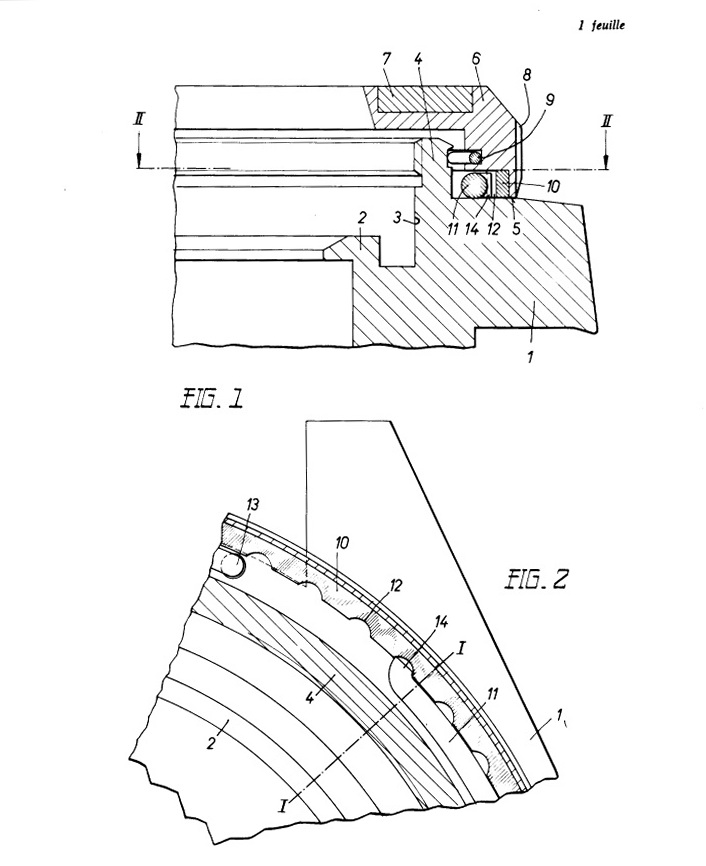
The Reference 844 models are fairly traditional dive watches, with many key design cues “borrowed” from the Rolex Submariner. The case measures 42 millimeters across the dial, although finding the spot for the measurement can be challenging; measuring the bezel will produce a more uniform result, at 39 millimeters. Prominent elements of the Heuer Reference 844 dive watch include the short, rounded lugs and large crown guards. The bezel is marked in minutes, with hash-marks from zero to 15. A walk around the dial shows that the first Heuer dive watches borrowed a fair amount from the Rolex Submariner models – a luminous triangle for 12 o’clock; and rectangular lume markers at 6 ‘o’clock and 9 o’clock; a date window at 3 o’clock; and circles of luminous material for the other hour markers.
Perhaps the most distinctive feature of Heuer’s early Reference 844 dive watches was the numerals 13 through 24 printed in red, adjacent to the corresponding luminous markers for hours 1 through 12. These red numerals allow the user to read “military time” directly from the dial, without any need to convert the hours. Many companies making dive watches in the 1960s and 1970s used this same basic design, and we see Monnin producing watches for other brands that have dials that are nearly identical to the Reference 844.
Heuer’s dive watches proved to be a success for the company, allowing the company to remain in business through the late 1970s / early 1980s, while many other brands would fail.
Yes, facing significant financial challenges, Jack Heuer was forced to sell the family business, but the fact that there was a viable business to sell was itself an accomplishment. In this period, many other well-known Swiss watch companies were shut down.
1984 to 1991 — The 1000 Series
Heuer offered a wide variety of dive watches over the years 1978 through 1983, primarily referenced as the 844.xxx and 980.xxx models, and first used the name “1000 Series” for its standard collection of dive watches in its 1984 catalog. By the time that it was named the “1000 Series”, Heuer’s collection of dive watches consisted of over 40 models. Cases were stainless steel, two-tone (steel and gold or black and gold), coated in black, pewter or green, or gold-plated, and the catalogs pointed out that the quartz movements allowed for flatter cases. The 1000 Series dive watches carried forward key features from the Reference 844 and 980 predecessors, including short, rounded lugs and prominent crown guards.
The 1000 Series watches were water-resistant to 200 meters, with some “Super Professional” and “Super Water Resistant” models extending that to 1,000 meters.
For additional information about the Super Professional dive watches, see TAG Heuer Super Professional — The Ultimate Collector’s Guide
Heuer catalogs emphasized the legibility of the watches, with extra-large luminous markers. Assessing these 1000 Series dive watches, we see the origins of the “six features” that Heuer would use in marketing its dive watches for over 15 years.
TAG Heuer must have been fond of the 1000 Series name, as many existing models of mechanical chronographs were shown in the catalogs as 1000 Series models. Chronographs shown in the 1000 Series section of the 1984 Heuer catalog include Autavias, Calculators and Monzas, as well as various models powered by the Lemania 5100 movement.
The 1000 Series collection had a relatively long run, remaining in the TAG Heuer catalog through 1991, when they were replaced by the 1500 Series.
For additional information about the 1000 Series collection, see Heuer / TAG Heuer 1000 Professional — The Ultimate Collector’s Guide.
For a table providing detailed information about the 1000 Series dive watches, see the OnTheDash Reference Table of Dive Watches.
1982 to 2004 — The 2000 Series – TAG Heuer Adds Fashion to the Dive Watch
The 1000 Series dive watches met with success in the late 1970s and early 1980s, but Heuer realized that there were limitations in the collection. Design-wise, the 1000 Series watches were well within the four corners of traditional dive watches, mimicking styles that originated in the 1950s. Functionally, the 1000 Series collection was limited primarily to three-hand dive watches, as Heuer did not develop new 1000 Series chronographs to complement the dive watches.
In 1982, Heuer addressed these limitations with the 2000 Series, a collection that offered a “completely new fashion look.” The collection included a greater variety of styles and materials, moving well beyond the traditional look of a dive watch.
In view of the fact that there is a somewhat limited range for creativity in the design of dive watches, it is not surprising that the bezels were the defining elements of the 2000 Series watches, with the collection including two different styles of bezels. The more traditional bezel (shown below) was flat, with an aluminum insert, and knurling around the edge.
The second style of 2000 Series bezel had more prominent grips, in a rectangular / capstan shape, which the catalogs sometimes described as “lugs”. The updated 2000 Series watches also featured a new style bracelet, replacing the “jubilee” from the 1000 Series. With the 2000 Series, Heuer also extended its line-up of dive chronographs, with a wide selection both quartz and automatic models.
In 1995, TAG Heuer updated the 2000 Series line, to create the second generation of the Series. Once again, a new style of bezel was the center of attention. The bezel was now 12-sided (which mathematicians call a “dodecagon”), with the same style of oversized “grips” as on the first generation. The hour markers on the dial now have metal surrounds, with an oversized “12” at the top. The hands remain traditional, with the Mercedes for the hour and a lollipop for the seconds hand.
The third generation of the 2000 Series came in 1998, when the collection was divided into three lines — the 2000 Classic, the 2000 Exclusive and the 2000 Sport models. The 2000 Classic watches continued the traditional style of the 2000 Series watches. The 2000 Exclusive models (as shown below) were bolder, with a heavier, stronger looking bezel, restyled hands and oversized numerals on the dial at 6, 9 and 12.
The 2000 Sport models (the predecessor of the Aquaracer) had an aluminium bezel with prominent lume-filled numerals around the dial. These 2000 Sport models took some style elements from the very first Heuer dive watches, including the traditional Mercedes style hands and the red / black bezel. There were relatively few models in this first line-up of 2000 Sport models, as the 2000 Sport line would soon be replaced by the new Aquaracer model.
After a short run, the 2000 Sport series was discontinued in 2002, but returned in 2004, as the 2000 Aquaracer. As such, the Aquaracer represents the fourth generation of the 2000 Series dive watches.
On the very first Aquaracer models, dials were marked “Professional”, rather than “Aquaracer”, but catalogs and advertisements referred to the new model as the 2000 Aquaracer. Defining features of the first Aquaracer dive watches were aluminum bezels to match the dial, a yellow second hand so that the diver can easily see that their watch is operating, and waterproofing increased from 200 feet to 300 feet. The first 2000 Aquaracer models met with great success, prompting TAG Heuer to relaunch the full 2000 Series model line as the “Aquaracer” in 2005.
The 2000 Series was deleted from the TAG Heuer catalog in 2005, leaving a legacy of dozens of models of watches and chronographs and being continued as the Aquaracer, which remains in the TAG Heuer catalog to this day.
For additional information about the 2000 Series, see Heuer / TAG Heuer 2000 — The Ultimate Collector’s Guide.
1984 to 1990 — The 3000 Series – It’s All About the Bezel
By 1984, TAG Heuer was doing well with the 1000 Series and 2000 Series dive watches and chronographs, and wanted to capitalize on this success by adding a “premium” collection of watches and chronographs. The 3000 Series would be this premium collection, described in the 1984 catalog as offering “functional elegance for high performance instruments.” Once again, the bezel was the most easily-recognized element of this upscale design. The catalog proclaimed that Heuer had “devoted maximum attention to the function of the turning bezel”. The bezel was designed for maximum legibility and maximum ease of handling, being 12-sided, rather than round, with small black balls attached to each facet to improve the grip.
The 3000 Series watches and chronographs have a stepped look. For example, the Reference 932.206 model (shown below) measures 38 millimeters across the dial, with the bezel measuring 34.5 millimeters, and the dial measuring a relatively small 25 millimeters.
At launch, Heuer offered four styles of 3000 Series watches (steel case with gray dial; two tone steel and gold case, gold case with black bezel, and matte black case with gold bezel), each in Heuer’s four standard sizes. The 3000 Series chronographs incorporated these same four styles, and were available with quartz or automatic movements.
The 3000 Series had a relatively short life, disappearing from the TAG Heuer catalog by 1990.
For additional information about the 3000 Series, see TAG Heuer 3000 — The Ultimate Collector’s Guide.
1990 to 1997 — The 1500 Series
TAG Heuer introduced the Series 1500 watches in 1990, and the watches make their first appearance in the 1991 catalog. The Series 1500 was positioned below the Series 2000, offering “safety and reliability” at an attractive price. The 1997 catalog describes the 1500 as having no superfluous refinements, offering all the features of an authentic sports watch, with simple and efficient design. The watches offer the modern look of the 2000 Series, with cleaner lines (for example, thinner lugs).
As with the 2000 Series, the 1500 offered two different styles of bezels — a flat bezel, with knurled edges (as shown below, right), and a bezel with raised triangular “grips” (as shown below, left and center). The 1500 series also featured models with a distinctive “granite” dial, a finish not offered in any of the TAG Heuer’s other dive watch collections. Bracelets for the 1500 Series were a new design, with five rows of links in a thinner style.
The 1500 Series included the classic “six features” — a unidirectional turning bezel, luminous hour markers, screw-in crown and a stainless steel case, waterproof to 200 meters, with a mineral crystal. Bezels were either traditional smooth finish or with triangular “studs”.
The 1500 Series made its last appearance in the 1997 catalog.
For additional information about the 1500 Series collection, see TAG Heuer 1500 — The Ultimate Collector’s Guide
1991 to 1997 — The 4000 Series
In 1988, TAG Heuer introduced a new flagship model, the S/el (Sports Elegance), an elegant range of watches that could be worn “with the dinner suit or the wet suit”. Three years later, in 1991, TAG Heuer would introduce the 4000 Series, a new range that it described as bridging the gap between the technology of the 2000 Series dive watches with the elegance of the S/el line.
The 4000 Series watches are easily recognized by the “split logo”, with the “TAG” being fixed in position as part of the case and the “Heuer” being part of the bezel, so that it rotates. The 4000 Series watches were offered in three sizes, with quartz or automatic movements, with a variety of steel and bi-metallic cases and a wide range of dial colors. The 4000 Series was never extended to include chronographs.
The 4000 Series made its last appearance in the 1997 catalog. This coincided with TAG Heuer’s introduction of the Kirium collection, its new line of avant garde watches.
For additional information about the 4000 Series collection, see TAG Heuer 4000 — The Ultimate Collector’s Guide
1992 to 2002 — The 6000 Series — The Prestigious Sport Watches
TAG Heuer launched the 6000 Series of watches in 1992. Once again, TAG Heuer was raising the bar for its flagship series of dive watches, hailing the 6000 Series as “the most prestigious of sport watches.” Most movements were automatic, rather than the previous quartz, with some models certified as chronometers. In addition to the standard stainless steel cases, there were 6000 Series models offered in 18 karat gold (yellow or white) and platinum.
The Series 6000 watches are most easily identified by the abundance of TAG Heuer shields incorporated into the watch. All models have TAG Heuer in a shield at the bottom of the case, between the lugs. The bezels are also distinctive, with the 10-20-30 marked in indentations that allow the user to grip the bezel.
The 6000 Series was offered for 10 years, being discontinued in around 2002. At that time, TAG Heuer began to shift its focus away from the numbered series of dive watches, with its key collections including the Link, Kirium and Alter Ego, along with an emerging series of classics, the Carrera, Monaco, Monza and Targa Florio. The 2000 Series was the only “numbered” Series to continue in the catalog, remaining until 2005.
By 2005, the numbered series of dive watches – 1000, 1500, 2000, 3000, 4000 and 6000 – had run their course, with TAG Heuer launching the Aquaracer as the successor to the 2000 Series. After all these collections, models and executions, TAG Heuer’s dive watches would be a single collection, the Aquaracer.
For additional information about the 6000 Series collection, see TAG Heuer 6000 — The Ultimate Collector’s Guide
The Aquaracer Arrives
As we have described above, the 2000 Series was introduced in 1982 and moved through different four generations over the next 20 years. In 2004, TAG Heuer launched a model called the 2000 Aquaracer, available in either a 38 millimeter case (with a quartz movement) or 41 millimeter case (with an automatic movement).
At its launch, the Aquaracer departed from the 2000 Series predecessors in several respects. Most noticeable was the use of an aluminum bezel, in the standard black, as well as indigo (deep blue) and silver. Going back to the style of the very first dive watches of the late 1970s, the rectangular hour markers of the 2000 Series were replaced by luminous circles. TAG Heuer also increased water resistance on the new Aquarcer, from 200 meters to 300 meters. The case-back of the first Aquaracer featured a dive helmet, and this remains a feature of the Aquaracer to this day.
The “2000 Series” name was dropped by 2004, and the Aquaracer took hold, as a new collection.
By 2005, the Aquaracer collection was fully developed, comprised of a broad range of watches and chronographs, with automatic or quartz movements. Models for women were available with diamonds on the bezels and dials, as well as dials with white or pink mother-of-pearl.
For an overview of the four generations of Aquaracer watches and chronographs produced by TAG Heuer, see TAG Heuer Aquaracer — The Ultimate Collector’s Guide.
The Aquaracer Tribute to the Reference 844
On April 7, 2021, TAG Heuer introduced an updated version of the Aquaracer, with the new models — called the Aquaracer Professional 300 — representing the fifth generation of the Aquaracer. The larger model measures 43 millimeters across the dial, but is thinner and lighter than the previous generation of Aquaracers. Cases are stainless steel, and the 12-sided bezel has a ceramic insert. The dials have horizontal lines, consistent with the ribbed look of previous models of the Aquaracer. The markers for the hours have been restyled, as octagons, surrounding the bright white luminous inserts. The date window has moved from the traditional position on the right side of the dial (at 3 o’clock) to the bottom of the dial (at 6 o’clock), with the magnification provided by a lens under the sapphire crystal, so that the top of the crystal is smooth.
Consistent with the approach that TAG Heuer employed with its dive watches in the 1980s and 1990s, the new Aquaracer will also be offered in a 36 mm case, with the smaller cases to be marketed to both men and women. The 36 millimeter models are offered in the same black, gray and blue dial colors as the 43 millimeter models, the differences coming in the wavier style of the horizontal lines across the dial and diamond markers for the model with the blue dial.
The new generation of Aquaracers incorporates some defining elements from TAG Heuer’s dive watches from the 1980s and 1990s. The 12-sided unidirectional bezel evokes the distinctive bezel of the 2000 and 3000 Series, with the same ergonomic and functional advantages. The sword-shaped hour hand reminds us of the last of the TAG Heuer 2000 Series, from 2004.
TAG Heuer has redesigned the case-back of the newest Aquaracer, with the dive helmet remaining the central image, but the theme of polygons (8-sided and 12-sided) being continued all across the case-back.
Included among the 43 millimeter models of the new Aquaracer is a limited edition model that will catch the eye of the vintage Heuer enthusiasts. TAG Heuer has gone back to the very first dive watch that it created, in 1978, to offer a tribute to the Reference 844 dive watch. The dials of the standard-issue Aquaracers have a ribbed finish, with horizontal lines, but the dial of the Reference 844 is a matte, orange-peel finish. In place of the bright white lume on the dial and hands of the standard models, the Tribute to Reference 844 has a rich, creamy tone, consistent with the vintage predecessor. The signature element of the earliest Reference 844 dive watches was the numerals 13 through 24 printed in bright red, and the tribute carries forward this element.
The original Reference 844 dive watches were shown in the catalog on a rubber strap and the Tribute to Reference 844 comes on a rubber strap, that evokes the original straps. The eight-sided holes in the strap follow the octagon theme of the watch, and a new style of buckle offers micro-adjustment, without taking the watch off the wrist.
Folks who collect vintage Heuer watches have become accustomed to TAG Heuer creating new watches to celebrate important events and personalities from the brand’s heritage. The Autavia chronograph that was re-issued in 2017 celebrated the models worn by champions Jochen Rindt and Mario Andretti in the 1960s, and we have seen gold Carreras honoring the relationship between the Ferrari Formula One team and Heuer, as well as the heroes Ronnie Peterson, Clay Regazzoni and Mike Hailwood. The Monaco chronographs celebrate Hollywood star Steve McQueen and the Monza pays tribute to the Formula One world championship won by Niki Lauda at the Italian racetrack. The Skipper re-issued by Hodinkee x TAG Heuer reminded enthusiasts of Heuer’s role in the defense of America’s Cup, in 1967.
The Aquaracer Tribute to Reference 844 takes a different approach. Rather than celebrating a racer, a team or a sport, the new Aquaracer pays tribute to a moment in the history of the Heuer brand, the moment when Jack Heuer decided that there was a good opportunity for Heuer to offer moderately-priced, good-quality dive watches. The Heuer Reference 844 dive watch was created in that moment.
The Reference 844 dive watch represented the most important moment in the chapter of Heuer and TAG Heuer making dive watches, for it was Heuer’s very first dive watch. After the Reference 844, Heuer and TAG Heuer followed with hundreds of dive watches and chronographs that met the same criteria that made the Reference 844 a success – stylish, reliable and affordable. Automatic or quartz; stainless steel or gold; 28 millimeters or 42 millimeters; red, orange, yellow, green, blue, black, white or gray . . . 1000, 1500 or 2000 Series. And after making these watches for just over 25 years, in a dizzying series of collections, TAG Heuer captured the best of these collections in creating its new Aquaracer collection.
It begins to sound almost biblical. The Reference 844 dive watch begat the Aquaracer in 2004 and from this first Aquarcer there followed four generations of dive watches and chronographs, in a variety of colors and configurations. From the classic blue that was used in the first models to the phantom and charcoal of the later models, the Aquaracers changed with the times, to reflect popular styles and preferences. There were watches and chronographs, stainless steel cases and titanium, larger cases and smaller cases. But it’s the Reference 844 that is the subject of TAG Heuer’s tribute in 2021.
And the Reference 844 dive watch is a worthy subject for celebration. Yes, it saved the company in the early 1980s, when many competitors failed. And the same design elements that contributed to the success of the Reference 844 dive watch in the late 1970s will contribute to the success of the Aquaracer in 2021. These watches are attractive, reliable and affordable. Jack Heuer knew that this would be a winning formula back in 1978 and it is still working for TAG Heuer in 2021.
Special Thanks
Thanks to Justin Bennett, at tag1000diver.com, for the advice regarding the early Heuer dive watches. Justin offers parts and service for the early Heuer and TAG Heuer dive watches, and also offers these watches for sale.
Jeff Stein
April 26, 2021
